The motor-vehicle industry is facing many challenges worldwide, and these are largely being underpinned by the insufficient throughput of new-car production and supply to the Japanese and European franchise markets.
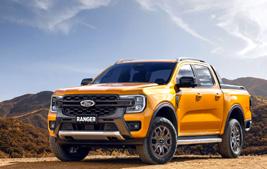
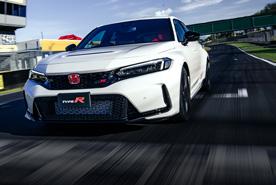
That’s the view of Simon Beirne, managing director of Christchurchbased SBL International Vehicle Brokering.
He points out New Zealand has historically relied on good-quality Japanese vehicles to complement our fleet.

“The Japanese new-car franchises feed auction houses their excess stock, but in the current climate it simply doesn’t exist. We now find more Japanese consumers are turning to second-hand vehicles, which in turn is impacting on availability and prices when accessing them for New Zealand.
“Good quality used vehicles are now in high demand for dealers in Japan and we are competing against them like never before to secure stock.

“The 2014-2020 window is where a lot of our dealers’ interest is at and that’s where the Japanese domestic market also sits. In addition, there’s not so much diversity when it comes to available models, even for consumers in Japan.”
Because new-vehicle production has plunged mainly due to the worldwide microchip shortage, franchises in Japan aren’t getting as many trade-ins, and dealers in the domestic market can pay over and above Kiwi importers.
Beirne says when it comes to the “sweet spot” of $20,000 to

$40,000 retail, a lot of product exists in Japan. But with many Japanese facing delays of between eight and 18 months for their new vehicle, they are upgrading to those two to four years newer than their current model, which they will then trade when their new car arrives.
He adds: “The yen is at a 15-year high with its cross-rate of 86-87 with our dollar, so dealers should be realising strong gross profit. But with the current buying conditions it feels like the rate, relative to success percentages, is in the low to mid-60s.
[continued on page 4]
GLOBAL VEHICLE LOGISTICS NZ - JAPAN - AUSTRALIA - UK - SINGAPORE DECEMBER 2022 www.autofile.co.nz THE TRUSTED VOICE OF THE AUTO INDUSTRY FOR 35 YEARS p 26 Meet most powerful Type R Ranger wins NZ Car of the Year p 24 Celebrations at finance awards p 14 Kiwi gets ‘Bahrain job’ done p 28 ‘Turbulent’ times hit used-imports
Rising competition and prices for wholesale stock in Japan creating concerns for many parts of the automotive market
An insufficient supply of new vehicles in Japan is putting increased demand on used exports
sector
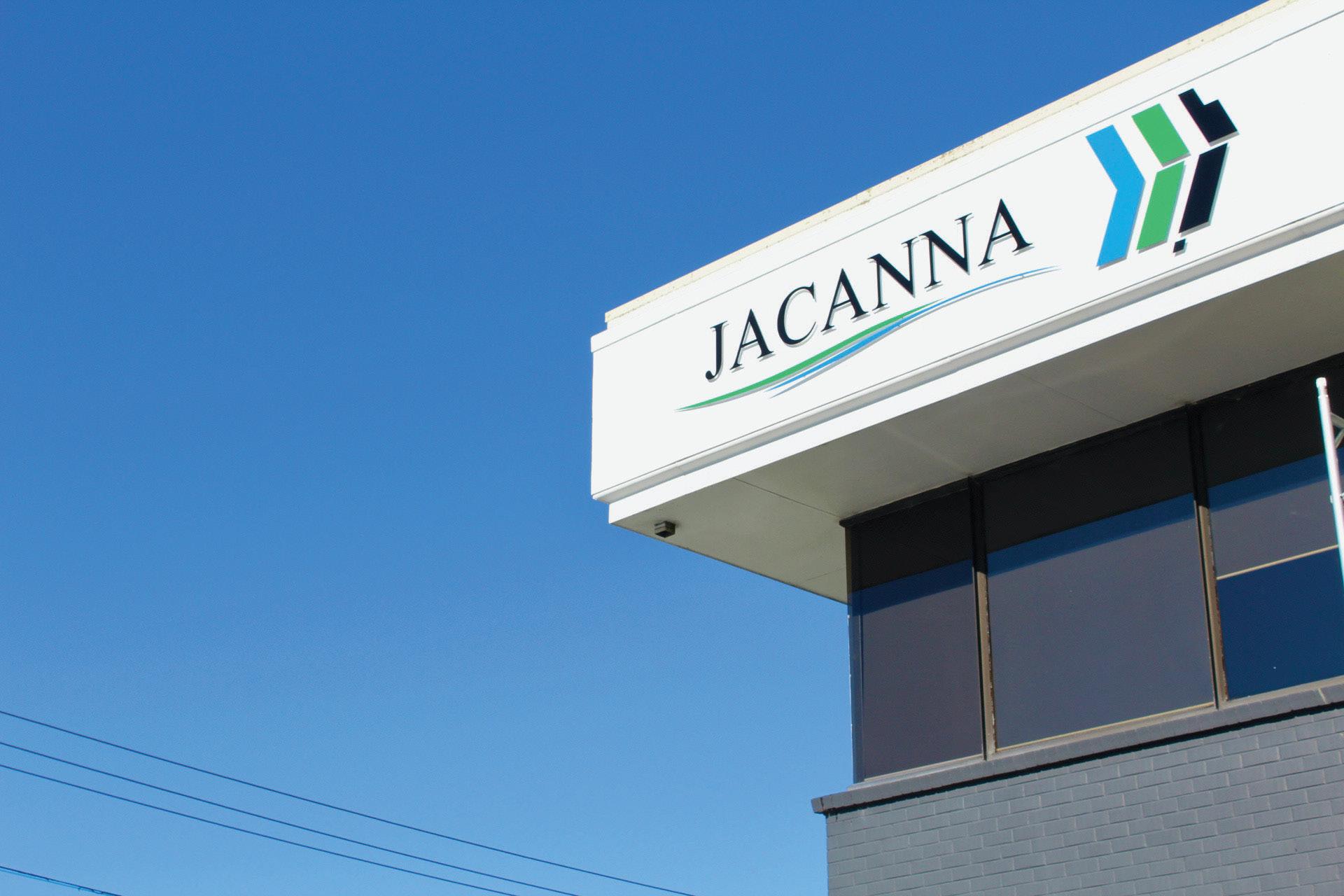

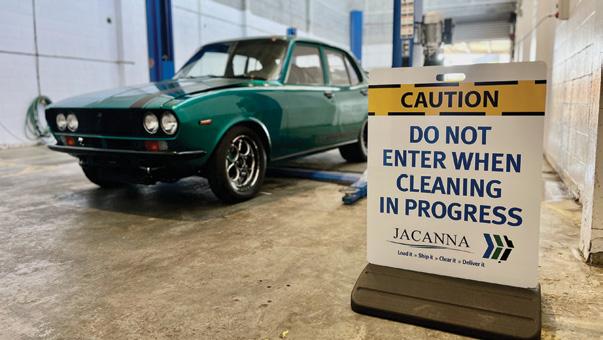
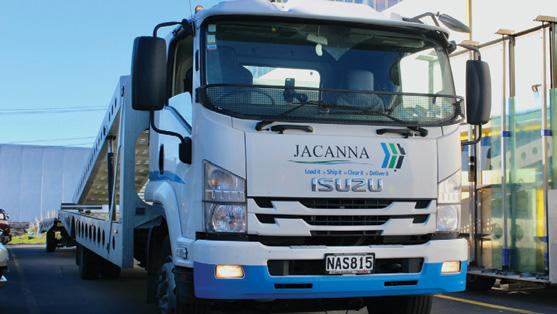

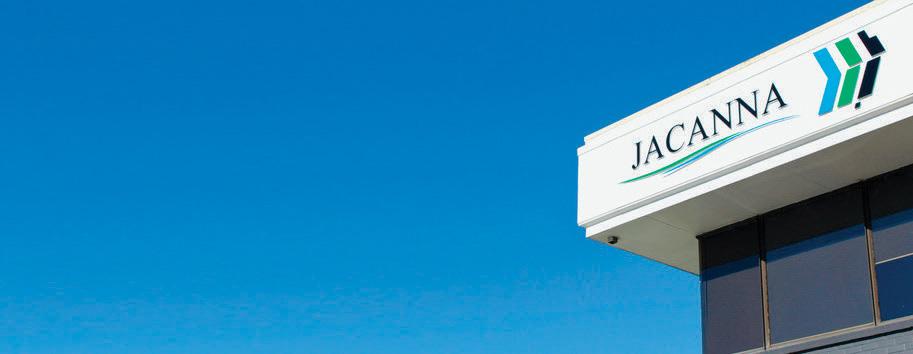

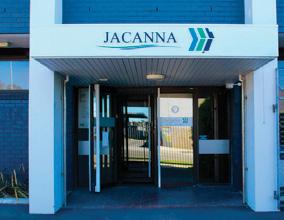
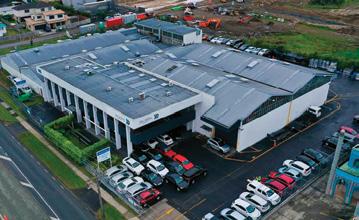

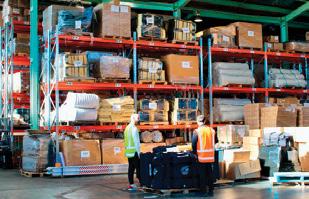





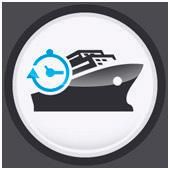
JACANNA.CO.NZ
to
larger premises means we are to offer even more services to our dealer clients BIGGER IS BETTER www.jacanna.co.nz Tel: +64 9 825 0888 Capping it all off is Jacanna’s SmartTrade Rewards Programme, you can earn points for almost any reward you choose to door ro-ro vehicle shipping from Japan and Australia Containerised vehicle shipping from anywhere in the world Vehicle tracking Approved MPI transitional facilities and cleaning services LOAD IT SHIP IT TRACK IT CLEAR IT DELIVER IT !
move
new, much
are specialists
transporting
exporting
Vehicles,
trucks, vehicles
Cargo & Machinery.
FREIGHT We have developed a worldwide network of Agents who understand the commitment required to service our demanding market.
TRACKING
out where your vehicle is at any one time of the process, gives you the ability to manage the collection and processing of documents and payment on time. SHIPPING SCHEDULE TRS and shipping services from Japan to New Zealand.
info@jacanna.co.nz Tel: +64 9 825 0888 Terms and conditions apply.
VEHICLE SHIPPING We
in
and
all types of
Commercial
of Special Interest and other RORO Heavy
GENERAL
VEHICLE
Finding
www.jacanna.co.nz
Outlaws’
There’s a great scene in Butch Cassidy and the Sundance Kid. Butch turns to Sundance and says: “Boy, I got vision and the rest of the world wears bifocals.”
Well Butch, we hear ya. Not in terms of the world so much, just Michael Wood, the Minister for Immigration, and his officials. Because while we see the problem and solution clearly, they seem blind to it.
The problem is simple. There’s a severe shortage of skilled workers to fill vacancies in our sector. Butch’s crew was the Hole in the Wall Gang, we’re the Hole in the Workforce Gang.
One industry expert puts the current number of vacancies at 2,000. It’s the number-one issue keeping MTA members awake at night – businesses forced to close, owners deferring retirement and picking up the tools, mental and physical strain on workers.
We’re also in the safety business. Fewer workshops, or ones stretched wafer-thin, means some motorists are forced to delay essential repairs and maintenance.

Ideally, there would be plenty of young Kiwis entering our industry and healthy local competition for vacancies. However, despite record numbers of apprentices, this shortfall still exists.


So, we need a fix that bridges the current shortage and the future when the local talent pool is deep. Let’s make it easier, temporarily, for overseas workers to come here and fill those vacancies.
However, that’s going to be nigh on impossible. Apart from a couple of roles on the immigration green list, most overseas workers will struggle to meet the number of points needed to work here because their levelfour qualifications fall well-short of what’s required.
This undervalues those workers, and the contribution they make to the industry and communities. Overseas workers can co-exist with apprentices. In fact, they can help train and support them.
The requirement for residency that immigrants are paid oneand-a-half times the median wage is unrealistic and unreasonable as salaries tend to be influenced by external factors outside of employers’ control.
Either expand the green list to include automotive tradespeople or expand the proposed qualification skill category to include level-four qualified automotive tradespeople being paid the median wage. It’s that easy and fair.
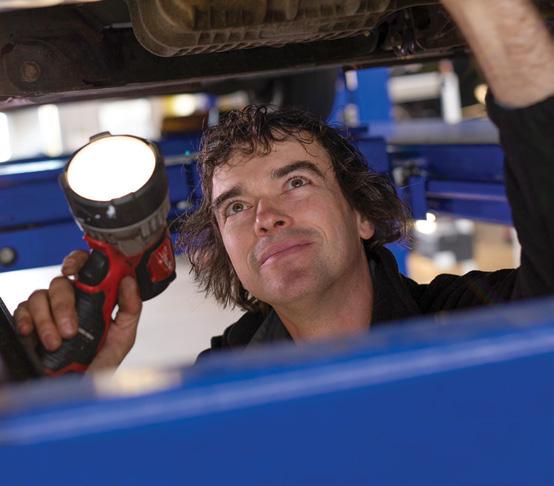
We don’t want our industry to be dependent on overseas workers forever, just through this difficult period.
Back to Butch and Sundance. There’s another great line in that movie when the Kid tells Butch to “just keep thinking, that’s what you’re good at”.
Minister, keep thinking. Keep thinking about how our industry’s pain can be fixed without any harm to nurturing local talent. You really don’t need 20/20 vision to see the answer.
Entry Certification Specialists

www.autofile.co.nz 3 Vehicle Inspection NZ
• Entry Certification for imported cars • Vehicle Appraisals • Pre-Purchase Inspections • WoF • CoF • Road User Charges • Registration & relicensing • Exhaust emission testing 0800 GO VINZ VINZ.CO.NZ
Call Steve Owens now on 021 947 752 GUEST EDITORIAL
inspiration to solve immigration DIRECTORS Brian McCutcheon brian@autofile.co.nz ph. 021 455 775 Darren Wiltshire dazzz@autofile.co.nz ph. 021 0284 7428 DESIGNER Adrian Payne arpayne@gmail.com EDITOR Darren Risby ris@autofile.co.nz JOURNALISTS Sue Brebner-Fox sue@autofile.co.nz Matthew Lowe matthew@autofile.co.nz MOTORSPORT Mark Baker veritas.nz@xtra.co.nz Autofile magazine is also available online as a readable file or downloadable as a PDF. Subscriptions are available at Autofile Online – www.autofile.co.nz Back copies are also available on the website.
Published monthly by 4Media Ltd
statements made, although based on information believed to be accurate and reliable, cannot be guaranteed, and no liability can be accepted for any errors or omissions. Reproduction of Autofile in print or digital format in whole or part without written permission, whether by copying or any other means,
strictly forbidden.
rights reserved.
(print)
(online)
Copyright:
All
is
All
ISSN 0112-3475
ISSN 2350-3181
Motor
IAN PIKE Chief executive officer
Trade Association
Ian Pike calls on government to unlock door to tackle industry’s staffing crisis
“Overall, volumes of used vehicles to New Zealand from Japan are coming down because there are also more players in the market, such as Malaysia and Russia.
“The value of Russia’s currency strengthened when European oil and gas contracts recently changed to being paid for in roubles instead of US dollars. This has resulted in Russia’s ability to secure more stock out of Japan.”
When it comes to Kiwi dealers’ used-imported stock levels, Beirne says: “My feeling is most of the industry would be 30-40 per cent down on last year’s figures, so that’s getting pretty close to the balance sheet wanting to see some positive changes.

“In addition, with inflation where it is, and increasing mortgage and commercial lending rates, the journey ahead continues to face challenges and the cloth in our industry may need to be cut to suit this ever-changing market.
“I’ve been in the industry for 33 years and the market has never
been as turbulent as what we’re seeing now.”
Beirne says New Zealand is in a completely different world now to where it was because of Covid-19 and we “seem to have a government intent on disassembling the motor industry”.
“We’ve never seen so much legislative change with significant impact for all concerned for many years.
“Although VIA, for example, has been working tirelessly with the
government, we aren’t getting the traction needed when it comes to the likes of the clean car standard. Some dealers hardly understand what this will mean and some may not know what they’re in for.
“We all want a cleaner fleet. However, we need sensible lead-in times for it to all work.
“Three years ago, BEVs and PHEVs were about five per cent of our volume. They went up to about 15 per cent during the last final stages of Covid-19 and postcoronavirus they are at about 25 per cent. That said, strong demand in New Zealand and Japan is pushing up their used prices.
“Japan was late as a nation globally on the take-up of BEVs and PHEVs, and the pool of these vehicles is significantly less than many of its foreign counterparts.
“Japan’s focus has been on hydrogen. That is where its focus on research and development has been. It sees hydrogen as the next catalyst and they are probably correct about that, but it’s taking a lot longer to realise its ultimate potential.
“Global appetite for shipping used BEVs is diminishing – already there are several shipping lines that won’t freight them to Australasia.
“This is being fuelled by insurance companies globally stating vessels will not be insured if there are used BEVs on-board, which will impact on the current New Zealand government’s clean car policies.”
VOLUMES ESSENTIAL
The number of used-imported vehicles from Japan to New Zealand is predicted to drop in the
coming years, with a warning this may spell trouble for a number of businesses.
Frank Willett, managing director of Autohub NZ, says any decline in used imports will impact many parts of the supply chain – from shipping lines to finance companies – because their sustainability is directly connected to volume.

While this year’s number of overall used imports will be close to 100,000 units, he predicts that problems for businesses will arise if the annual total ever falls as low as it did during the global financial crisis (GFC) 13 years ago.
“I think the number of usedimported vehicles in New Zealand will decrease over the next few years,” Willett told Autofile.
“Vehicle pricing means the range of viable vehicles that we can import used from Japan will drop and the selection range will decrease.
“Of deep concern is if the annual volume of used imports from Japan drops below a certain level.
“If that happens, there’s a risk shipping-line space may decrease and prices increase, and supplychain members – such as preexport vehicle-processing services – may retrench causing further cost increases and delays.
“Onshore, we have a lot of automotive industries that depend on used imports. Workshops, compliance, panel and paint shops, groomers, warranty companies, parts suppliers, finance companies, IT system developers and so on all require a certain volume of work to remain viable.
“During the GFC in 2009, the used-import arrival volume for that year dropped to about 70,000 units, but that was a relatively short-lived period of low arrival numbers. Currently, if we hit that low again, there will be attrition in the usedvehicle support infrastructure.”
The exchange rate between the New Zealand dollar and yen is the highest it has been for a number of years, and that would normally be conducive to buoyant trade for used-vehicle importers.
However, the global shortage of semi-conductors has dented production levels for new cars
4 www.autofile.co.nz
news [continued from page 1]
“I’ve been in the industry for 33 years and the market has never been as turbulent as what we’re seeing now”
If you are a forward thinking motor vehicle trader, or financier, looking for a trusted vehicle insurance partner, call Quest. Contact: Russell Bowater 021 790 365 russellb@questinsurance.co.nz QUEST INSURANCE OFFERS: an independent choice Mechanical Breakdown Insurance – backed by AA Roadside Assist Comprehensive Motor Vehicle Insurance Lifestyle Protection Insurance Credit Contract Indemnity Insurance Mechanical Breakdown Insurance for Electric and Hybrid Vehicles Guaranteed Asset Protection Insurance
– Simon Beirne, SBL
and this, combined with other factors, has seen increases in the demand and prices for used vehicles in Japan.
Willett notes Japan’s economic outlook is also “not that flash at present” with the government showing no intention of delivering an economic stimulus, which has left the country “trying to limp out of Covid-19 in a constrained way”.
“The yen-NZ$ exchange rate has been reasonably good for us,” he says. “In ‘normal’ market conditions, we would be rubbing our hands together and enjoying some extra buying power.
“At the moment though, there’s an ongoing shortage of new vehicles for various reasons, such as a shortage of parts and microchips. This has had a flow-on effect to sales and deliveries of new cars in Japan.
“This means there’s an increased demand domestically in Japan for low-mileage vehicles that we’re not used to seeing.
“For our market to get access to late-model, low-mileage vehicles, people have to be trading them in when they get a new car but that’s not happening as much. This is driving prices of cars we want upwards, so it’s negated the benefits of the exchange rate we would normally be able to take advantage of.”
While the exchange rate with Japan at present may be favourable, Willett highlights that companies here are copping some financial pain because the kiwi is weak against the US dollar. This causes problems for New Zealand businesses because many of the costs incurred in the supply chain are payable in America’s currency.
There are several other challenges facing importers –domestically and internationally. As a result, Willett has heard of dealers contemplating exiting the industry.
Another factor impacting the volume of used cars crossing our borders from Japan is extra demand from other markets, such as Russia and Australia.
While there’s an embargo on many goods from Japan to Russia, this sanction doesn’t cover most used cars and there has been a “dramatic increase for near-new
vehicles heading to Russia”.
Willett adds: “We’ve also got Australia coming onto the buying scene and widening its uptake of late-model, near-new used models from Japan. This is being driven again by a short supply of new cars and a growing interest in hybrids.
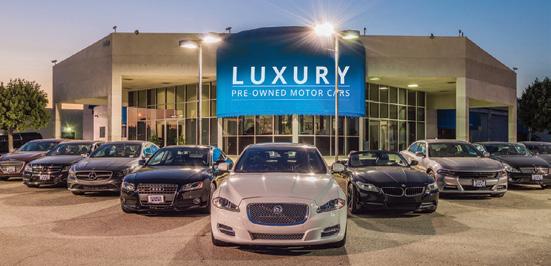
“Used imports into Australia five years ago would have mostly been collectibles and performance cars, and campervans.
“Now there’s no onshore vehicle manufacturing to protect, the interest there along with compliance-system changes will see growing volumes of used Japanese vehicles entering Australia. It appears this will be mainly made up of hybrids.”
Options for sourcing usedimported cars is limited because New Zealand is a right-hand-drive country and its standards regime restricts where vehicles can be sourced.
Willett emphasises our usedimports industry thrives on having a market mostly to itself with New Zealand one of the main buyers of such stock from Japan.
“It makes it hard when other markets cross into our sweet spot. They may have consumers who are used to paying more for cars, such as in Australia, so importers from those markets can pay more at auctions. With 95 per cent of our used vehicles coming from Japan, things are looking rather tenuous at present.”
A global push to tackle climate change has also seen the demand for low and zero-emissions vehicles out of Japan increase. In turn, their prices have climbed substantially in a short time.
Willett says Japanese hybrids and EVs are keenly sought after in many markets and, in some instances, their prices have gone up about 30 per cent in two years. The introduction of the clean car discount has also played a part in driving prices up.
He predicts the clean car standard (CCS), which will target vehicles at time of import from January 1, will make it increasingly harder to secure low and zeroemissions vehicles, especially as
the government’s carbon dioxide (CO2) targets become tougher over time.
Nevertheless, there will still be a market for vehicles with internal combustion engines (ICEs) that attract penalties under the standard.
USED-CAR VALUES UP
Businesses importing used cars from Japan are having to pay “over the odds” for higher quality vehicles despite the yen’s cross-rate with the kiwi being weak.
“Either dealers in New Zealand will have to wait out recent price hikes or adapt their buying patterns and what they pay,” says Patrick Davey, owner of vehicle export agent Davey Japan.
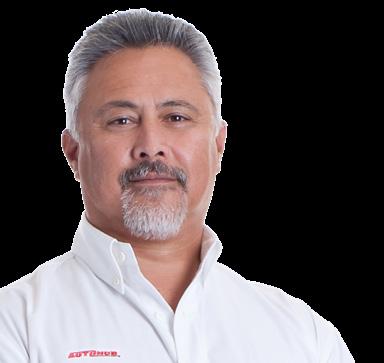
“The used-car market in Japan is now more global than ever and that also affects pricing despite whatever’s happening in New Zealand. The yen is very weak compared to the kiwi dollar, but it’s also weak compared to the US and Australian dollars, and the British pound.
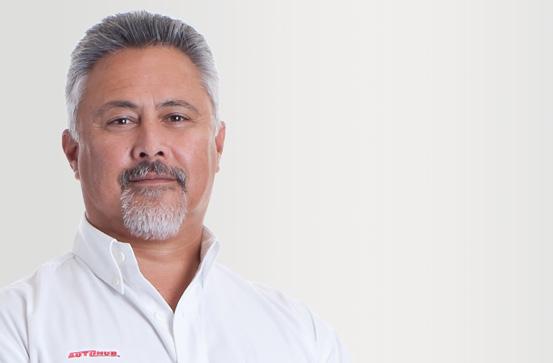
www.autofile.co.nz 5
t news
[continued on page 6]
“Of deep concern is if the annual volume of used imports from Japan drops below a certain level”
Contact us now to find out more A better deal for the Motor Vehicle Trade Ph: 09 320 5646 www.autobridge.co.nz n Flexible credit facility available to fund vehicles in transit or on your yard n Access to stock when you want to buy, not only when you have the available cash n Free up your capital and grow your business n Only available to registered motor vehicle traders
– Frank Willett, Autohub
“The value of many used cars is getting higher as the yen decreases. However, the main reason for the difficulty in buying has been a lack of stock at auctions. Numbers have been down and the selection is tight.”
Davey says dealers in Japan’s domestic market are electing to retain better stock, which in turn means lower auction numbers, “so when a decent car pops up at auction, most times you have to pay well over the odds for it”.
In addition, global instability is pushing up the US dollar, “so it’s stronger than ever”, there are tensions in east Asia, such as Taiwan and North Korea, and there have been at least two years of volatility in international shipping.
Competition for used vehicles has grown with Russia taking more and Davey has also noticed an increase in exports from Japan to Australia in recent years, which he sees continuing into the near future.
All that said, the bottom line is wholesale numbers in Japan have dropped, while the choice and quality of cars have been low.
“This means you have to fight pretty hard and back yourself if you want to get your hands on good stock,” advises Davey.
That has always been the case, he notes, but more so when discussing July through to the end of October. He does point out, however, that there was an increase in Japanese auction numbers and “a bit of relief” in pricing during the first few weeks of November.
“Used vehicles across the globe are more expensive now although there are signs of things stabilising a bit. Green vehicles are in demand as well as full electrics, such as the Nissan Leaf, so these see the highest resale values.
“Production and domestic retail sales have been on the rise in the past three to five months here in Japan, but still lower than 2021 as a whole. It seems the industry is slowly recovering in terms of sales and production. Japanese buyers still tend to prefer new vehicles and regulations that promote purchasing new rather than used are still in place to support that trend.”
Global automotive markets
have been navigating choppy waters over the past few years with various factors creating a nearperfect storm – the pandemic’s impact on factory output and logistics, the subsequent microchip shortage, unstable uneconomic and geopolitical conditions, and cost-of-living crises.
On the flipside, Davey, whose company is based in Fukuoka and has staff across the country, says Japan to New Zealand and other supply-chain issues are stabilising compared to a year ago.

“There were some serious staffing issues at port yards to carry out inspections and other outbound services, but that also seems to have been mostly corrected these days. Some shipping lines are rejecting used BEVs, which has been problematic.”

The New Zealand government’s clean-car policies have also impacted on the used-imports industry.
When discounts were first offered to Kiwis on BEVs and PHEVs in July 2021, prices for such used models in Japan went up by the same levels as the rebates, “eradicating any saving that was supposed to be passed onto end users in New Zealand”.
Since the full clean car discount scheme was rolled out on April 1, Davey says there has been a bigger jump in prices of zero and lowemissions vehicles with the rebates. This along with the rising cost of fuel, a lack of stock and demand from other jurisdictions have all contributed to higher Japanese auction prices.
These topped out in July through to September, while
October saw “slight relief” for lowemitting models’ prices as they started to decrease for the first time in a while.
As for future regulations in New Zealand, such as changes to the vehicle emissions rules to Japan 05 or Euro 04 standards and the CCS, Davey says: “Our team of buyers here, as well as dealers in New Zealand, will have to be ahead of all this and adapt to the changes.
“It seems to coincide with buyer preferences in many cases because more efficient cars are in demand. We’re working to ensure traders are aware of models that comply and help them find the best models for their yards. There’s quite a bit of confusion among the dealer network in regard to changes due to arrive in 2023.”
As for total used imports coming to New Zealand from Japan decreasing this year when compared to 2021, Davey says: “It seems this would cause prices to rise as the maths implies a low supply. Cars are flowing out of Japan quite smoothly, so eventually this should stabilise.”
LIMITED RANGE
An exporter warns the range of used EVs able to be shipped from Japan to New Zealand is limited because of the inability to produce on-board diagnostics (OBD) reports for a number of cars.
This means the growing demand from Kiwi consumers for used low and zero-emissions vehicles is being channelled towards those mostly made by Japanese marques, which is pushing up prices for those models.
Taka Arimoto, assistant sales manager of the New Zealand department of Japan-based Heiwa Auto, says there are many challenges across the supply chain for used imports, but this was the biggest issue for his company.
He notes used EVs the company cannot ship from Japan to New Zealand at present include the Peugeot e-2008, Volkswagen’s e-Golf, the Jaguar I-Pace, BYD’s E6 and Teslas.
The situation has arisen after a roll-on, roll-off vessel caught fire and sunk off the coast of the Azores in Portugal in March.
Since then, there has been discussion in the industry about requiring all BEVs to have battery condition reports before being shipped.
“We have been notified by a shipping company that the aforementioned vehicles cannot be loaded because an OBD diagnostic device has not yet been developed,” says Arimoto.
“This issue will result in more demand for EVs from Japanese manufacturers and raise the market price.”
He adds the introduction of the clean car discount in New Zealand has also influenced the range of vehicles importers are wanting to buy.
Many of Heiwa Auto’s customers have already indicated an intention to change from high-displacement sports cars and coach-type vehicles to hybrid or all-electric vehicles.
“Compared with 2020, the average car price has gone up around 60 per cent for us,” adds Arimoto. “This means dealers who are mainly targeting those under $10,000 retail are finding it difficult to buy cars.
6 www.autofile.co.nz news
[continued from page 5]
There has been a noticeable rise in the number of used cars being exported from Japan to Russia. Many are going to the port of Vladivostok
[continued on page 8]
Patrick Davey, of Davey Japan
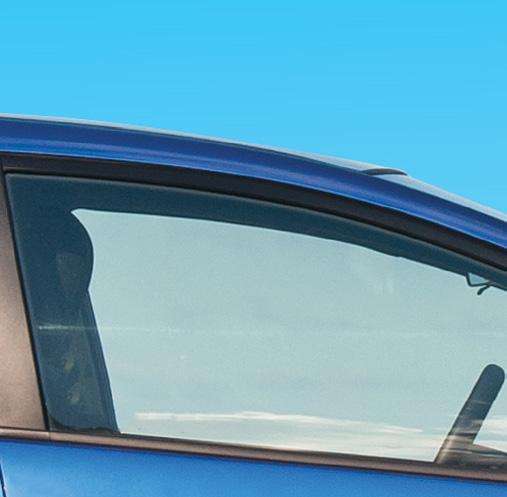
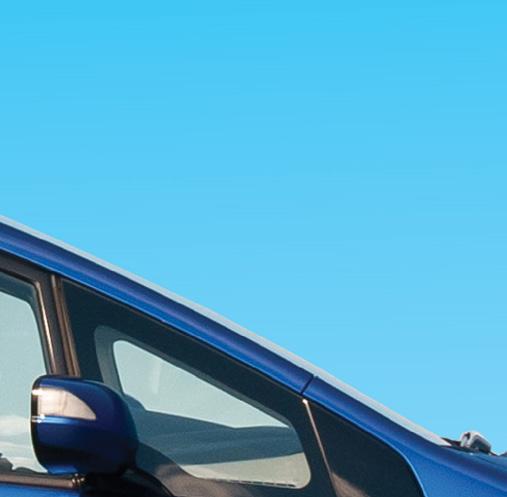

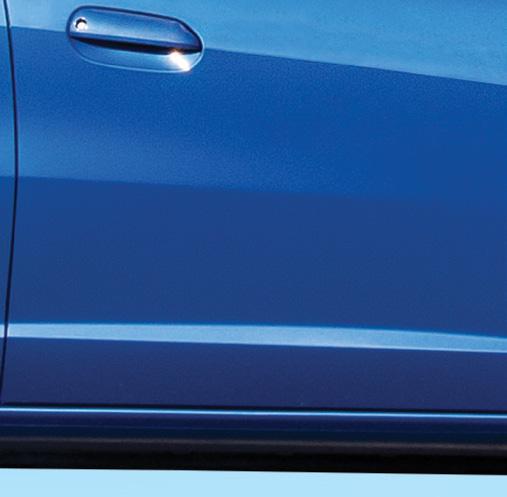
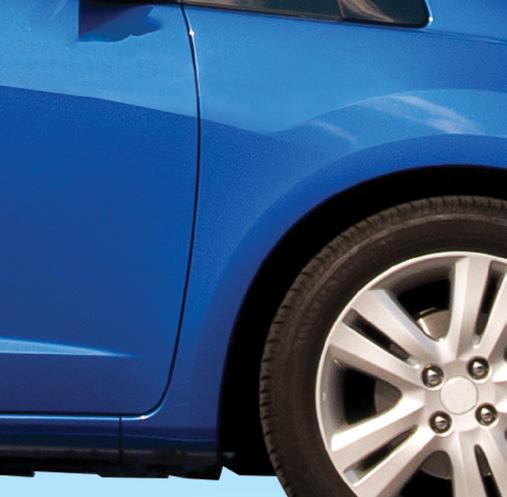
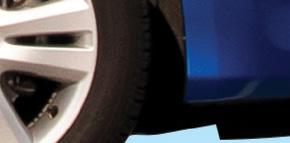

DON’T SWEAT THE ‘C’ WORD COMPLIANCE SHOULDN’T BE A DIRTY WORD. PROTECTA MAKES IT EASY. With the recent changes to the Credit Contracts and Consumer Finance Act (CCCFA), you can be assured that Protecta have got you and your customers insurance compliance needs covered every step of the way. Talk to us to find out more today! contact@protecta.co.nz | 0800 776 832 www.protecta.co.nz
Top five countries for used-vehicle exports from Japan: 2017 to 2022
“The clean car discount makes cheap cars unpopular because most of them attract a penalty. As a result, competition at auctions is concentrated on the most popular models – mostly hybrids and EVs – resulting in fewer purchases overall.”
While the clean car discount may be impacting the vehicle choices of importers and consumers, Arimoto says it is the competition from other markets for hybrids and EVs that is the main factor driving up auction prices.
He notes more environmentally friendly models were already popular among other markets, such as Europe, Russia and Australia, and this has initiated more intense bidding at auctions.
For example, Australia’s number of used imports from Japan is increasing at the same time New Zealand’s imports are falling. As a result, Arimoto says he has heard reports of many export agents in Japan trying to get into the Australian market.
“The stock level in Japan is
nearly the same compared to last year and the demand for cars from overseas is very high except for New Zealand,” he adds. “However, I don’t think the New Zealand market will run out of stock.”
New Zealand has started to widen immigration and, if China opens its border, more people will come to this country and they will need cars.
“But before that, I think the New Zealand government needs to improve its economic policy. Then the New Zealand car market can get the ability to compete with other countries on price at auctions.”

He predicts the New Zealand government’s plans to raise exhaust emissions standards for new and used imported vehicles will also have a significant impact on future export volumes.
The combination of factors weighing on the used-car industry at present is making it harder for
dealers operating at the lower end of the market, according to Arimoto, and may lead to major changes for the industry.
“I believe there will eventually be stronger competition among car dealers in New Zealand and smaller and cheaper car dealerships will be eliminated from the market.”
He explains if that happens it may increase the profit margins from car sales and make the market more stable, which will allow surviving dealers to better adjust to the market’s buying conditions.
Arimoto says New Zealand dealers in the used-import business may also benefit if they convert to “a quality and more profitable business rather than a volume business”.
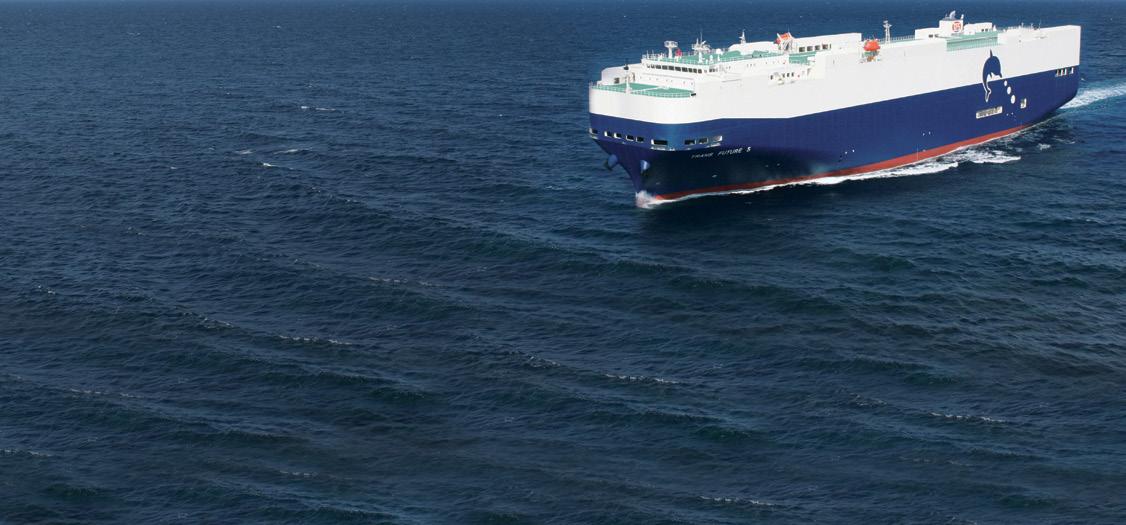
“I believe that the era of feeding volume and seeking cheaper terms is over, and that shifting to a business that emphasises quality of vehicles and quality of service is
essential for the future development of the used car business.”
Other factors in Japan affecting the market for used vehicles include a weaker exchange rate than that of countries that continue to raise rates, and ongoing issues related to Covid-19.
Global issues he cites that have boosted demand for more fuelefficient cars and lifted the price of EVs include petrol prices increasing since Russia invaded Ukraine in February this year, and strict environmental policies in many countries on vehicle imports.
Despite the headwinds facing parts of the supply chain from Japan to New Zealand, Arimoto says he remains optimistic for the industry.

“Just as we have been through bad times in the past, there will surely come a time when the current bad market situation will turn around. In order to be prepared for that time, we, as exporters, are putting our first priority on strengthening our relationships with our customers.”
8 www.autofile.co.nz
Adam
www.toyofujinz.co.nz FROM JAPAN TO NEW ZEALAND ON TIME, EVERY TIME T/S = Tranship to next available TFS vessel Toyofuji vessels Voyage JAPAN NEW ZEALAND Moji Osaka Nagoya Yokohama Auckland Lyttelton Wellington Nelson Trans Future 7 141 21 Nov 24 Nov 26 Nov 15 Dec 17 Dec 18 Dec 19 Dec Trans Future 3 277 5 Dec 6 Dec 10 Dec 22 Dec 25 Dec 26 Dec TBA Dream Jasmine 24 TBA TBA 15 Dec 5 Jan 9 Jan 11 Jan 12 Jan Trans Future 5 145 21 Dec 22 Dec 24 Dec 12 Jan 14 Jan 16 Jan 17 Jan Trans Future 6 142 2 Jan 3 Jan 7 Jan 26 Jan 28 Jan 30 Jan 31 Jan TOYOFUJI SHIPPING
Contact:
Stone adam.stone@toyofujinz.co.nz
SCHEDULE
[continued from page 6]
news
2017 2018 2019 2020 2021 YTD SEP 2022 2017 - YTD 2022 TOTAL
9.5%
4
5
Top 5 total
1 Russia 5.3% 69,039 7.2% 95,074
122,597 11.9% 126,418 13.2% 162,249 15.6% 138,250 10.1% 713,627 2 United Arab Emirates 11.1% 144,323 9.6% 126,706 13.2% 171,505 12.8% 135,932 10.9% 133,233 11.2% 98,800 11.4% 810,499 3 New Zealand 10.4% 135,509 8.8% 116,253 8.6% 111,806 8.3% 87,999 8.6% 104,954 7.1% 63,115 8.7% 619,636
Tanzania 3.7% 47,563 4.4% 58,598 4.3% 55,882 4.7% 49,501 5.1% 62,428 5.8% 51,071 4.6% 325,043
Kenya 5.7% 73,921 5.8% 77,268 6.1% 78,454 5.9% 62,940 6.0% 73,460 5.0% 44,530 5.8% 410,573
36.2% 470,355 35.7% 473,899 41.7% 540,244 43.6% 462,790 43.8% 536,324 44.8% 395,766 40.6% 2,879,378
Taka Arimoto, of Heiwa Auto
SHRINKING FEELING
The size of the used-car market in Japan is predicted to shrink in coming years as motorists there hang onto their vehicles for longer because of problems affecting the production and deliveries of new cars.
Keisuke Nagashima, director of border-inspection organisation Bordercheck, says there are currently waits of up to two years for new cars in Japan, which means many people are holding onto their existing vehicles for longer until their new ones are ready to be picked up or shipped.
It also means there are fewer trade-ins happening and a number of Japanese dealers are seeking to replenish their stock by buying through auction.
“Five to six years down the track there’s going to be a decrease in available vehicles within the used car market because of how new car sales are going at the moment,” predicts Nagashima.

“The industry is quite robust

and flexible, and will find other products that meet the requirements of the market.
“However, I also think the market will shrink altogether in terms of how many people stay in the industry. It’s going to require some thinking on your feet to remain successful.”
Nagashima adds the biggest challenges for Bordercheck are the availability of space on ships and the scheduling of vessels.
He explains the current demand for new vehicles in New Zealand and Australia often means there’s a lack of vessel space for used cars, which has an impact on inspections.
“On top of that, ships coming back to Japan from Australia have often been delayed in port because of the current industrial action, which makes it hard for us to forecast how many vehicles need to be inspected per vessel.
“We haven’t been too badly
affected as a business because we’re not solely reliant on New Zealand vehicles and we cater for other markets, but it is certainly tough at present. Ultimately, we’ve been dealt a deck of cards and we simply have to do the best we can.”
The New Zealand government’s clean car programme is expected to continue to influence what importers are buying at auctions and the numbers involved.
However, Nagashima warns the government’s targets appear to be overly ambitious given EVs only account for a “minimal percentage” of the Japanese fleet.
“The rest of the fleet is hybrids and ICE vehicles. It will be hard to balance the number of used EV imports needed to meet expected demand in New Zealand versus the actual supply available in Japan.”
Nagashima notes the average
price of vehicles is going up at auctions and says a reason for that, besides increasing domestic demand, is rising international interest from Russia and other countries.
“Other countries are also competing with New Zealand for stock and their consumers seem prepared to pay more for vehicles than we are.”
Despite the ongoing RussiaUkraine conflict and restrictions on certain vehicles being exported from Japan, thousands of used cars are still being sent to Russia.
“Historically, Russia has been a high importer of used vehicles out of Japan and that situation hasn’t changed much, but the vehicles it is now targeting are more in-line with what New Zealand importers are also wanting to buy.”
Nagashima says the recent drop in the yen has favoured a number of countries besides New Zealand and the state of the economy here has also made buying at auction harder for Kiwi businesses.
www.autofile.co.nz 9
t news
Keisuke Nagashima, of Bordercheck
Kiwi insurer gains global clout
Protecta Insurance is preparing for the dual challenges of advances in vehicle technology and changing consumer behaviour under new owners after being taken over by New York-based Assurant.

The Kiwi business was founded in 1986 and started trading the following year. It sells a range of vehicle-related insurance products through dealerships, finance companies and direct to consumers.
Assurant, through wholly owned subsidiary Virginia Surety Company (VSC), has been working with Protecta since 2018 as the underwriter for its policies.
As part of Assurant’s global growth strategy, with the company having a presence in more than 21 countries, it announced on December 1 it had completed the acquisition of Protecta.
News of the takeover plan was
first revealed to dealers in October this year when they received a letter saying the agreement was in the advanced stages of being finalised.
Protecta will now be led by Hemaka Perera, Assurant’s president, Australia, New Zealand and Singapore, and the Protecta management team of Bart Taylor, general manager direct business and chief commercial officer, Kevin McKay, chief financial officer, and Shannon Beech, general manager intermediated and agent business.
Perera says dealers will not notice an immediate difference in how Protecta operates, but in the long run the plan is to introduce new products and draw on the international knowledge and resources of its new owner.

“We want to ensure we deliver what dealers need, offering products that make sense to their vehicle sales and provide value for their consumers,” he told Autofile.
“We’ve been working with Protecta for four years and all products are underwritten by Assurant.
“When Protecta was looking for a new home, it just made sense to propose coming into the Assurant family, allowing us to bring some of our global capabilities into the country, making the Protecta proposition even stronger.”
Shannon Beech says Protecta is excited about the changes and, through its partnership with VSC, it is the only provider to offer add-on insurance issued by an A-rated insurer in New Zealand.
“Assurant’s global capabilities and technology, combined with Protecta’s local talent and expertise, position us for even greater success,” she adds.
Assurant is listed on the New York Stock Exchange and is a leading global business services company offering mobile device solutions, extended service contracts, vehicle protection services, renters’ insurance, lender-placed insurance products
and some other specialty products.
Martin Jenns, president of global automotive, says acquiring Protecta will enable it to provide a broader range of products and services, and “deliver a best-in-class customer experience that gives our clients and partners a strategic advantage in the New Zealand market”.
Perera acknowledges the automotive market has faced challenges related to the supply of vehicles and parts in recent times, which can impact sales, the volume of new customers coming into dealerships, and the cost and time of repairs.
“New Zealand is no different to many other parts of the world with regard to those struggles to date,” Perera explains.
“One of the challenges as we go on, and what we’re working on, is around the nature of vehicle ownership. The behaviour of consumers is changing, partly because of Covid and partly because of ride-share coming into maturity, which changes how people own vehicles and how they want to be protected.
“We strive to stay ahead of new technology like electric vehicles [EVs] because it’s not always easy to come out with solutions when technology is at its infant stage, as the risk early on is unknown.”
Assurant is working with partners worldwide to ensure it understands technology such as batteries and the value of EVs after a few years. In 2021, Assurant and Protecta launched Assurant EV One, an extended warranty product for electric and hybrid vehicles.
Perera adds: “We know the EV wave is coming – and we are investing in the technology that will give EV owners the peace of mind needed to embrace electric vehicles, while giving our clients and partners solutions that will elevate the customer experience.”
10 www.autofile.co.nz
news
Contact us today 09 966 1779 www.jevic.com SP E C I A L IS T S I N PRE‑SHIPMENT INSPECTIONS MPI biosecurity inspections Biosecurity decontamination Heat treatment NZTA border inspections Odometer verifications Pre-export appraisals ? Lost documentation reports
“We want to ensure we deliver what dealers need”
– Hemaka Perera
Martin Jenns
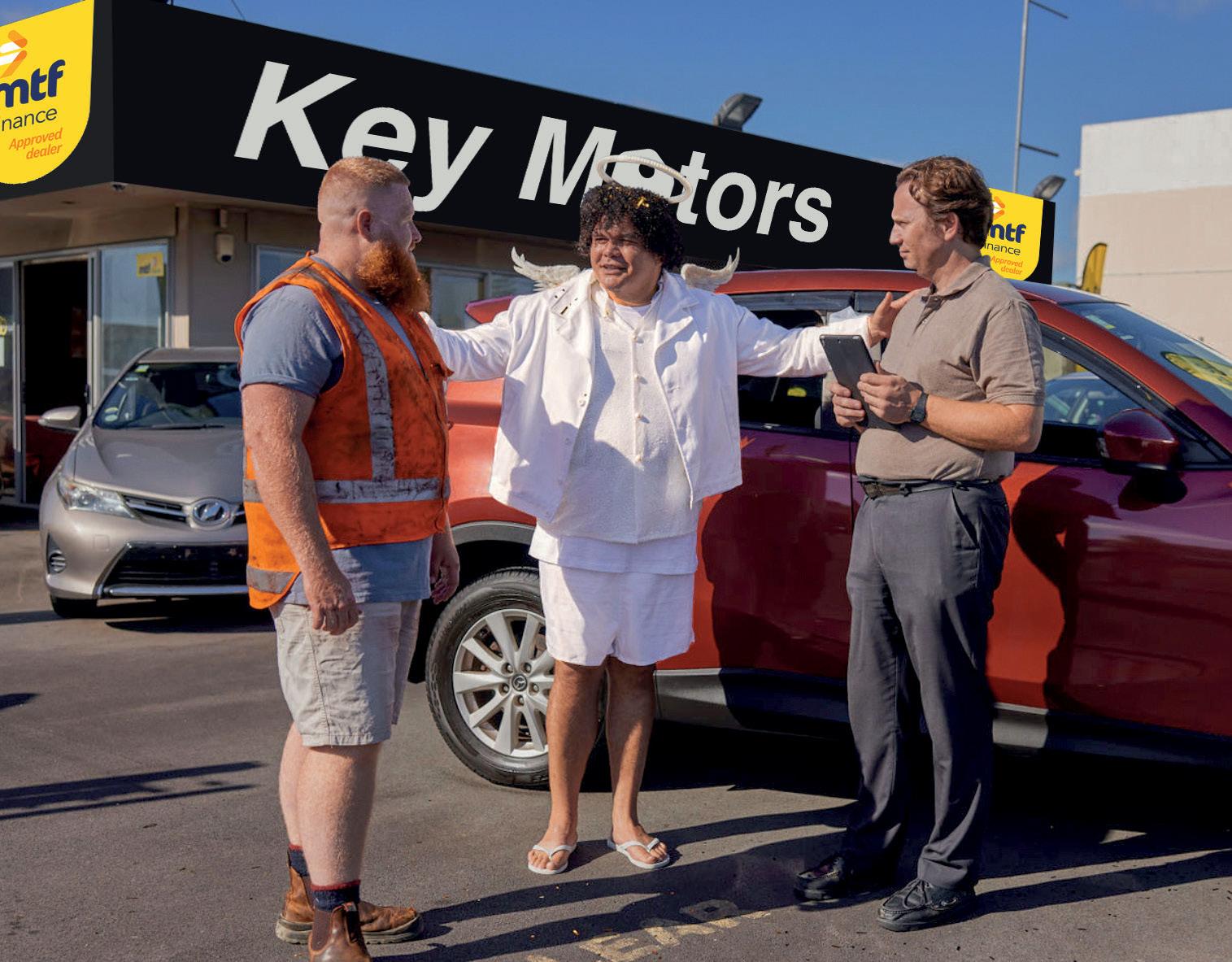
www.autofile.co.nz 11
trusted
partner?
a match made
your dealership’s
Join the trusted finance network that’s
sales
out more at
Helping New Zealanders do more since 1970 Our customers scored us 4.9/5 on Trustpilot® t
“A
finance
That’s
in heaven.” Looking to build
success?
been backing dealers for over 50 years. You’ll be working with a well-known Kiwi brand with access to a competitive product range, insight into your
portfolio, and support when you need it. Find
mtf.co.nz/join
Scheme ‘certainty’ at last
The phased roll-out of the clean car standard (CCS) is under way with importers now able to see the emissions of light vehicles they bring into the country in their carbon dioxide (CO2) accounts.
This month will allow dealers and other importers to get used to the online system set up by Waka Kotahi NZ Transport Agency before charges and credits start to be applied from January 1.
Since November 28, importers and entry certifiers have been able to assign a CO2 account number to a vehicle identification number (VIN) or chassis number in Fuelsaver.
It means that when VIN notifications are entered into the online database, this goes through to the motor-vehicle register and creates a transaction in the CCS system under the relevant CO2 account.
However, the payment of any charges under the new scheme has been deferred by the government until June 1, a move described by the Motor Trade Association (MTA) as a “win for our industry”.
Michael Wood, Minister of Transport, announced on November 22 the CCS will begin at the start of 2023, as planned, but any invoicing is on hold for five months to allow “smooth implementation” of the new approach.
The MTA previously urged Wood to delay introducing the entire CCS until April next year at the earliest.
“While not what we asked for, this decision is a win for our industry,” says Tony Everett, the MTA’s sector manager – dealers.
“It will allow dealers to establish credits in the first half of the year in preparation for when payments need to be made.
“In recent weeks, importers had been buying a little bit blind as to when the new rules will apply, so this finally adds certainty to the process.”
The CCS works by giving credits to importers for low or zero-
250 200 150 100 50 0 2020 (Measured) (Targets begin) 2022 2023 2024 2025 2026 2027
emissions vehicles, while imposing charges on other vehicles depending on their CO2 ratings.
Everett explains deferral of CO2 account settlement will allow time for the market to settle into whatever the new normal will be. Demand, and perhaps pricing, for low-emissions models in Japan may increase as importers target such stock to offset any “fee/ debit” impacts.
“The same thing happened when the clean car discount scheme was introduced in July 2021 and then after the second part in April 2022,” he adds.
Along with other industry groups, the MTA has been critical of the lack of information around the CCS with regulations for the scheme only announced on November 1.
“It has been hard for the market to plan with any certainty. We’ve raised the issue with the minister several times, so we’re glad he acknowledges he’s listened to industry,” says Everett.
WELCOME CHANGE
The Motor Industry Association (MIA) is pleased the government has fixed a “pointless” outcome of its original CCS legislation, with mopeds and motorbikes no longer covered by the rules.
Wood announced last month he would remedy the situation
that would have seen the standard apply to such two-wheelers once it was introduced.
The Land Transport (Clean Vehicles) Amendment Act, passed earlier this year, applies to any motor vehicle weighing less than 3,500kg.
It goes on to define vehicles that will incur penalties or earn credits under the CCS as light passenger vehicles and light commercials – namely cars, SUVs, utes and vans. Including mopeds and motorcycles was an inadvertent error that crept into the legislation when it was passed.
David Crawford, the MIA’s chief executive, says it came down to interpretation of the act and whether the section on the standard covered all light vehicles.
“The MIA welcomes the minister’s decision to amend the act under urgency to exclude mopeds and motorcycles from the ambit of part 13 of the act – the part that sets out requirements for the CCS,” he explains.
“The way the act was drafted imposed a bureaucratic encumbrance on importers of mopeds and motorcycles for no outcome. It was a pointless perverse outcome to be required to set up a CO2 account when the CCS only applies to importers of new and used passenger and light commercial vehicles.
“The MIA raised this with the minister in September when officials advised that in their view mopeds and motorbikes were caught by the act. The minister agreed with industry this wasn’t the intention, and we’re grateful he has resolved to amend the act to make parliament’s intention clear and unequivocal.”
The Imported Motor Vehicle Industry Association (VIA) is warning prices for used cars may increase by as much as 25 per cent early next year as dealers pass on the costs of the CCS to consumers.
David Vinsen, chief executive, says the CCS and the clean car discount, which became a full feebate system in April this year, is a “double whammy” for the usedcar industry.
“Prices of some vehicles will go down, like electric cars, but across the board, predictions are that there will be an up to 25 per cent increase in prices.”
VIA is also concerned that about 4,000 vehicles may unexpectedly end up copping costs under the standard after being caught up in shipping delays caused by a tug-operator strike at the Port of Brisbane.
The industrial action means the vehicles that were due to arrive in New Zealand at the beginning of December may not get here until the middle of the month and risk being unable to be processed before the new clean car rules come into effect.
New vehicles are likely to be affected by the delays as well and the sector is also expecting car prices to increase as a result of the CCS.
Wallis Dumper, managing director of Subaru of NZ, says the prices of most of its vehicles will rise five to 10 per cent in January and at the same time the marque predicts sales will tumble by at least 20 per cent.
He adds some of the pain facing the automotive industry – both now and over the coming months – could have been
12 www.autofile.co.nz
news
Clean car standard – annual CO2 levels Grams of CO2 per kilometre (WLTP-3) 224 218.3 201.9 155 116.3 87.2 145 133.9 169 112.6 84.5 63.3 Type B (light commercials) Type A (passenger cars)
avoided if the government had taken three or four years longer to roll-out its clean car policies.
“Our sales could halve purely because of supply,” explains Dumper. “Subaru in Japan has a 2027 plan to have its own assembly line for EVs, but I fronted up in Tokyo and said I need these cars for the next year and they went, ‘No, we can’t do that’.”
VIEW FROM BEEHIVE Wood says the decisions to phase in the CCS and defer invoicing until later in 2023 came following discussions with importers and he believes the timing will help deliver a successful roll-out of the scheme.
The minister says the policy will significantly reduce CO2 emissions from the light-vehicle fleet, which is the country’s single largest source of transport emissions.
“We need to increase the supply of fuel-efficient vehicles and give New Zealanders more choices in the variety of low and zero-emissions vehicles while also

doing our bit for global climate change. The standard will help us do this.
“The phase-in will see the payment of charges deferred until June 2023 to ensure a smooth implementation for the industry.
“We’ve heard the request from the industry for a delay and have worked together to confirm a timeframe that balances a successful implementation with the need for action. This short extension gets that balance right.
“The CCS will encourage importers to bring in vehicles with lower emissions, that burn less fuel and will stop New Zealand being the dumping ground for the dirtiest vehicles in the world.
“The general public will continue to benefit from the clean car discount scheme, which is seeing record numbers of EVs and hybrids being bought.
“I regularly hear from importers about how the upcoming introduction of the CCS is helping
them to access cleaner vehicles for the New Zealand market. The standard will complement this work with greater choices for consumers.
“The CCS is one of a number of initiatives in the emissions reduction plan to reduce emissions, improving our health, environment and well-being.”


The CCS requires importers to progressively reduce the CO2 emissions of light vehicles, both new and used, they bring into New Zealand. This is achieved by setting CO2 targets that get more ambitious year by year.
Legislation to enable the phased implementation of the CCS raced through parliament on November 22 and it received royal assent three days later.
Under the new rules, all vehicle importers needed to have a CO2 account where the emissions ratings of their vehicles will be recorded from the start of December.
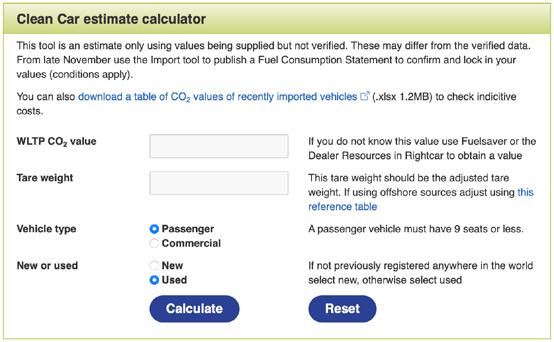
From January 1, the CO2 ratings of vehicles start to count towards achieving CO2 targets.
Why not ask what SBL can do for you?

www.autofile.co.nz 13
year we import thousands of vehicles into New
We manage every
of the importing process from
to your door. For our approved customers
can provide flexibility in funding a vehicle’s purchase. Ph. 03 377 6578 www.sbltd.co.nz Call us now and find out what everybody’s talking about.
Every
Zealand.
detail
Japan
SBL Finance
t
news
An estimate calculator for the clean car standard is online at https://importer.fuelsaver.govt.nz
Celebrating success in finance
Companies operating in the motor-vehicle finance industry have scored some notable victories at an annual awards ceremony.
The Financial Services Federation (FSF) staged the event on November 16 following a twoyear hiatus.
The gala evening and awards ceremony at The Hilton in Auckland showcased the positive impacts its members contribute to the sector and their customers.


It followed the organisation’s national conference earlier in the day, the theme for which was “innovation, conduct and empowerment”.
CFS Finance secured two trophies on the night with the first going to Daniel Aldridge, who was crowned workplace champion.
This award recognises “backstage heroes whose outstanding attitude and support work empowers their organisations to thrive”. The other two finalists were Rebecca Stuart, of Avanti Finance, and Irene Craig, also of CFS.
The leadership award celebrates those who empower their teams, promote good conduct, company culture and outcomes for customers.
This honour went to CFS’ Angela Jorgensen. The other finalists were Michael Harrison, of Avanti, and Kieran Stott, of DebtManagers.
Avanti also took out the community and sustainability award for FSF members involved in initiatives that have positive impacts on people’s lives. Go Car
Finance was the other finalist.
Oxford Finance claimed the award for team spirit with DebtManagers coming in as runner-up. This honour is for highachieving teams who look after each other and make where they work a good place to be.
The rising star award is for professionals new to the industry who demonstrate outstanding achievement and commitment to New Zealand’s responsible financial services sector.
The winner was Mark Wilson, of Latitude Financial. Chris Fifita, of DebtManagers, and Eona Ikilei, of CFS, were also finalists.
Finally, the innovation award recognises members displaying significant initiative and leadership to enhance their company’s or clients’ abilities to thrive. Centrix secured it, while the other finalists were Lexis Nexis and Equifax.


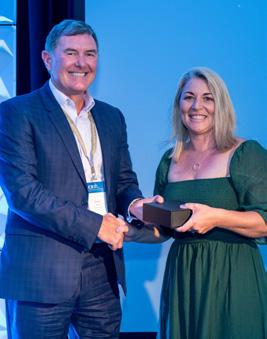
Lyn McMorran, the FSF’s executive director, says: “We started these awards four years ago because we were tired of dodgy lenders hogging the spotlight when so many excellent people in this sector take pride in their work and responsible lending seriously.
“There are 1.7 million New Zealanders who are customers of our members and countless stories of good borrowing experiences to go with that. These awards acknowledge that.”
She adds the entry criteria put particular emphasis on dedication
to good outcomes for consumer and business customers.
“The judges were impressed by Avanti’s co-ordinated effort across its business when it comes to people and the wider community,” says McMorran.
“Of note was its structured framework and dedicated resource to organise opportunities for staff to volunteer with the likes of Eat My Lunch, Ronald McDonald House, Motuihe Island Care and Helping Homeless Families.
“Avanti has also supported IHC to contribute towards development of an app to promote financial literacy for people with intellectual disabilities.”
This year’s judging panel comprised of Ruth Smithers, FinCap’s chief executive, Luke Ford, a partner at Chapman Tripp, and Susan Taylor, chief executive officer of Financial Services Complaints.
The award sponsors were Autosure, Centrix, Provident Insurance, Happy Prime, Speirs Finance and Equifax.
The line-up for the conference included David Clark, Minister of Commerce and Consumer Affairs, Andrew Bayly, National’s commerce spokesman, and Louise Unger, general manager of credit at the Commerce Commission.
Some of the speakers were Diane Tate, chief executive of the Australian Finance Industry Association, and ANZ chief economist Sharon Zollner.
14 www.autofile.co.nz news
Graeme Duncan and Priya Patel, of Avanti
Meurig Chapman, left, of Happy Prime, and Jason Smith, of Oxford Finance
Angela Jorgensen, of CFS Finance, and Steve Owens, of Provident Insurance
Awards MC Te Radar and Lyn McMorran, of the FSF
James Searle, of Autosure

www.autofile.co.nz 15 Lending criteria, fees, terms and conditions apply. a faster and more flexible way to get behind the wheel
vehicle lending
We offer
options,
wholesale
your customers
journeys. We provide access
an experienced
lenders,
personalised
service and nationwide coverage.
Curious to find out more?
Robson, National Sales Manager, NZ Dealer 027 688 9895 |
Remkes, NZ Broker Manager, Auto & Consumer 021 599 729 | nicole.remkes@avantifinance.co.nz *For complete and correct applications which meet our responsible lending criteria. Fees, terms and conditions apply. Our process will take longer if the application is not complete and/or we require further information in order to make a credit decision.
brandedfinancial.co.nz USED VEHICLE
New Zealand’s non-bank
specialists, just got faster and even more flexible.
a first-tier proposition, second-tier finance
and
floorplan finance. Our flexible solutions get
on the road faster and keep you moving forward with automated systems for smooth, uninterrupted
to
team of
outstanding
seven days a week
We work where you work.
Lee
lee.robson@avantifinance.co.nz Nicole
NEW VEHICLE FINANCE
FINANCE avantifinance.co.nz
Board breached NZX listing
Aregulator’s report into board changes at NZ Automotive Investments (NZAI) has concluded the company unintentionally breached an NZX directive.
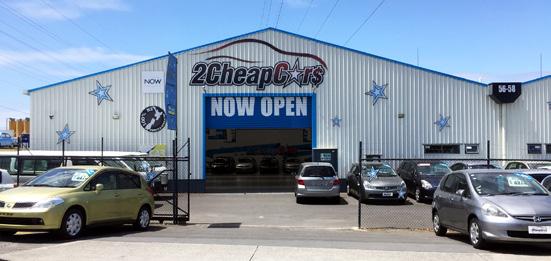

NZ RegCo has found that NZAI, which is the parent company of 2 Cheap Cars, contravened listing rule 2.7.1 when it decided not to put forward an appointed director for re-election at an annual shareholders’ meeting (ASM).
The regulator has determined to pursue an “educative, rather than enforcement, outcome” in relation to the breach.
NZAI, meanwhile, has welcomed the outcome of the regulator’s review and its subsequent report, which was published on November 18.
In its report, NZ RegCo acknowledges NZAI relied on legal advice in taking the view
that co-opted director Samantha Sharif was not required to seek reelection at the company’s ASM on September 2.
It adds NZAI fully co-operated with the investigation and “there is no evidence NZAI sought to intentionally circumvent the requirements of rule 2.7.1”.
Michael Stiassny, chairman of NZAI, says the company is now “moving on” and “it was an unintentional error that has had no negative impact on shareholders”.
An announcement regarding the appointment of a new chief executive officer is expected within weeks.
Stiassny adds: “As previously advised, Samantha Sharif’s term on the board will conclude once Gordon Shaw’s role as interim CEO ends and, consequently, his status as an independent director is restored.”
A statement to the NZX was issued by NZAI on July 19, 2022, that all then-directors – other than executive director Yusuke (David) Sena – had resigned.
It added those resignations would become effective when a sufficient number of new independent directors to meet rule requirements were appointed or by August 20, whichever happened first.
The announcement also identified three candidates nominated by Sena whose appointment would be voted on at NZAI’s ASM scheduled for August 25. Two people then withdrew their consent for nomination.
On August 10, NZAI announced the annual meeting would take place on September 2 and the company published the notice for it two days later.
The notice outlined Sena had undertaken to then-current board members that, on their resignations becoming effective on August 20, he would appoint Stiassny and Shaw as directors in-line with the company’s constitution to ensure board-composition requirements were met under rule 2.1.
Those appointments were temporary, with Stiassny and Shaw
to retire and offer themselves for re-election at the ASM.
At this time, NZAI’s chief executive officer was David Page, who had resigned on July 1.
The NZX was advised he would work out his notice until September 30. Over the weekend of August 20-21, he went on gardening leave for the rest of his notice period.
On August 22, the company announced it had appointed Shaw as interim CEO pending the appointment of a new chief executive. That meant Shaw no longer qualified as an independent director of NZAI.
It also stated it had appointed Sharif as an independent director on an interim basis pending the end of Shaw’s term as interim CEO, at which time he would revert to being an independent director. That announcement advised Sharif would seek approval of her appointment at the annual meeting.
Stiassny and Shaw were reelected at the ASM. Sharif wasn’t put forward for re-election.
NZ RegCo noted that Shaw stated, in his presentation to shareholders, that “as Samantha [Sharif] is a co-opted director, she does not stand for election”.
NZAI announced on September 2 that its board had reappointed Sharif as an independent director, effective at the ASM’s conclusion and on the same terms as originally appointed.
Rule 2.2.1(a) permits the board of an issuer to appoint directors if its constitution or governing document provides for such appointments. NZAI’s constitution gives its board this power.
Rule 2.7.1 limits this power by requiring board-elected directors to seek re-election. This rule states: “A director must not hold office [without re-election] past the third annual meeting following the director’s appointment or three years, whichever is longer.
“However, a director appointed by the board must not hold office
16 www.autofile.co.nz
Many thanks to our readers and clients for your support throughout 2022.
Have a safe and happy festive season and we look forward to working with you again next year
NZAI owns 2 Cheap Cars
t [without re-election] past the next annual meeting following the director’s appointment.”
This regulation reflects an underlying policy that appointing directors is reserved to shareholders, stated NZ RegCo in its investigation report. Although the rules contemplate a constitution may enable a board to appoint directors, these are temporary.
Such board-appointed directors must not hold office past the issuer’s next annual meeting following appointment. The NZX has communicated this interpretation of rule 2.7.1 in its guidance note on governance.
Board-appointed directors are eligible for re-election. The requirements of rule 2.7.1 are long-standing and are also applied under the then-NZX’s main-board listing rule 3.3.6 prior to a review in 2018.
Issuers have to comply with the rules as interpreted “in accordance with their spirit, intention and purpose, and by looking beyond

form to substance, and in a way that best promotes the principles on which the rules are based”.
NZ RegCo examined NZAI’s approach to reappointing Sharif on September 2 given the requirements of rule 2.7.1.
The company submitted Sharif retired as a director with effect from the end of the ASM. Accordingly, her position as a director ended immediately afterwards, consistent with that rule.
Rule 2.7.1, in NZAI’s view, was
to ensure a board did not become entrenched. Sharif’s appointment was limited to six months from when she joined the board or until a new CEO was appointed.
Given she was only temporary, there was no risk the action the board took would result in her position becoming entrenched. Accordingly, NZAI’s view was that Sharif’s reappointment was within the rule’s purpose.
NZAI also submitted the rules do not expressly prohibit the board from renewing a director’s temporary appointment for the balance of its term.

NZ RegCo interpreted rule 2.7.1 “in light of longstanding policy underpinning it”. While it could be interpreted in the manner put forward by NZAI, the regulator considered that would be inconsistent with that policy.
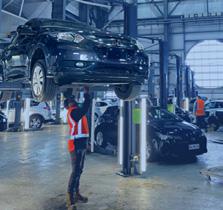
That approach could enable a board to avoid shareholder approval of a director indefinitely – for example, if board-appointed directors technically retired
at an ASM and immediately reappointed after it.
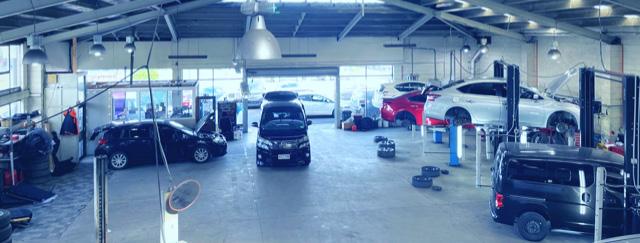
NZ RegCo noted rule 2.7.1 doesn’t distinguish between directors appointed by the board for a limited time and those without such limitations.
Issuers and their advisers must bear rule 2.7.1 in mind when considering governance and succession issues, states NZ RegCo’s report.
If permitted by a governing document, appointing directors can be effective in adding valuable skills and managing compliance with the board-composition requirements under the rules.
However, all board-appointed directors are subject to rule 2.7.1. This requires they retire at the issuer’s next annual meeting postappointment. They are eligible to seek reappointment at that time.
A board should avoid appointing new directors after it has released a notice for an ASM if it’s intended for them to continue to serve on the board post-meeting.
www.autofile.co.nz 17
news www.i4checkpoint.co.nz INSPECTION EXCELLENCE INDUSTRY INNOVATORS - NOT JUST ANOTHER COMPLIANCE PROVIDER Providing high-quality vehicle compliance services nRe-registration nWarrant of Fitness nCertificate of Fitness nEntry Certification If you’re looking for a compliance partner, reach out to us for a new way of doing things. CELEBRATING OUR FIRST YEAR DELIVERING INNOVATIVE COMPLIANCE SERVICES
Michael Stiassny, chairman of NZAI
Hat-trick for port dwell times
The amount of time taken to process vehicles imported through Auckland has remained the same for the third year in a row – and that’s despite volumes increasing over that timescale.
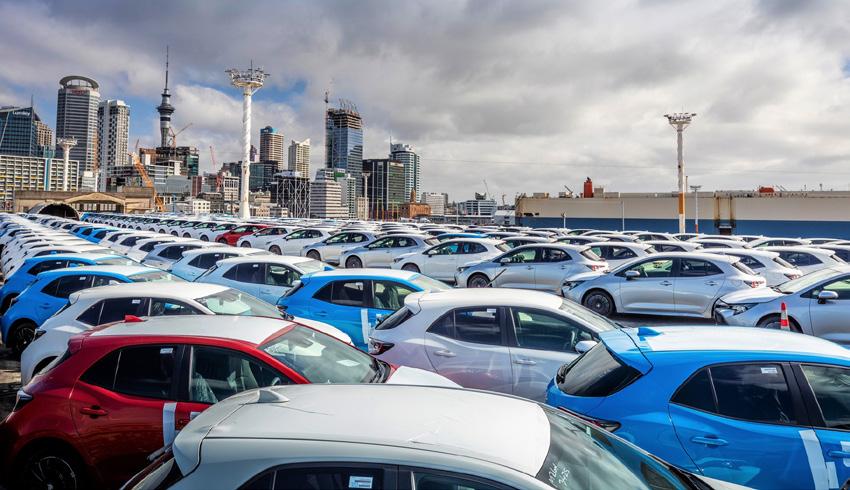
The average car dwell time at the port was 2.07 days in its 2022 financial year with units handled coming in at 240,544. That was up by 1.8 per cent compared to 236,260 in 2021 while 2020’s total was 216,356.
Freight volumes at Ports of Auckland Ltd (POAL) have “held up well” despite the continuing “challenging” global supply chain and congestion in the New Zealand system, reports chief executive Roger Gray.
It continued to be the largest port for imports, handling more than 10.8 million tonnes across containers, bulk cargo and vehicles in 2021/22 for an increase of eight per cent on the previous year.
Total break-bulk volume, which includes cars, climbed by 9.4 per cent to 7.293m tonnes. This compared to 6.666m tonnes in 2020/21. Container volumes slightly declined with total TEUs down by 0.8 per cent to 811,565.
All of this is quite an achievement considering external challenges POAL has faced over the past few years with Covid-19 – it has been affected by lockdowns more than any other New Zealand port – and supply-chain disruptions continuing to impact on its performance.
While the company’s financial results reflect the challenges of 2021/22 and board decisions to refocus the business, Gray believes “there are green shoots in returns from operations”.
Its net loss of $10.3 million –compared to the $45.57m profit in the 2021 fiscal year – results from writing off $63.1m in costs capitalised on the project to partially automate the Fergusson Container Terminal.
The board decided to terminate the scheme and return the terminal
to a manual operation for the foreseeable future.
On the flipside, revenue jumped to $265.3m, up by 17.2 per cent on 2020/21, while operating costs rose by 12.9 per cent reflecting cost controls in place.
Operating profit before tax, excluding impairments, revaluations and share in investments, came in at $27.4m for an increase of 32.8 per cent.
Gray stresses the company is committed to producing an adequate return on capital investments made in infrastructure.
“It has been a year in which we started to rebuild the foundations for Ports of Auckland’s future as a safe, customer-focused and profitable organisation,” he says.
“We’ve reset our strategic direction, and are clear on our focus on core business and delivery. Our new strategy, ‘regaining our mana’, and key pillars supporting it are designed to lift our performance significantly, deliver a reasonable return to our owner and rebuild trust with Aucklanders. We will execute regaining our mana over the next three years.”
POAL will continue to focus on improving its safety practices after a Construction Health and Safety NZ report, released in March 2021, made 45
recommendations for improvement.
“We accepted the urgency to implement, and have completed the recommendations with just fatigue management and training requiring longer to implement.
“There is a positive change in our culture. ‘Safety first’ is led by our board and management, and staff are empowered to speak up if they see something unsafe.
“Our people are telling us they feel more comfortable raising concerns and they are doing so. While this is a positive, we know safety work is never finished, we must always be vigilant, look after ourselves and others, and take care at work.”
As for POAL’s emissions, they fell by 8.3 per cent to 11,465 tonnes of carbon-dioxide equivalent (CO2-e) from 12,502 tonnes of
CO2-e in 2020/21, which is seen as a “positive step towards achieving sustainability goals”.
Gray notes: “The majority of imports through the port are delivered to customers in the wider Auckland region, meaning the carbon footprint of onshore delivery to end users is reduced.
“The port has developed a carbon calculator to allow customers to understand the environmental cost of shipping a container within the North Island.”
In addition, the company recognises improvement in harbour health as an “important sustainability pillar” in its environmental strategy, and is aiming to partner with stakeholders to support a thriving ecology in the Waitematā and Hauraki Gulf.
Looking to the future, Gray says: “We recognise the port’s importance as the key gateway for imports, and have refocused our strategy on our core cargohandling, cruise and marine businesses. We are committed to lift the levels of service and performance for customers, our people and Auckland.”
POAL is anticipating an improvement in performance to achieve net profit after tax of $35m for 2022/23, excluding investment property revaluations.
18 www.autofile.co.nz news
“We’ve reset our strategic direction, and we’re clear on our focus on core business and delivery”
– Roger Gray, POAL
Ports of Auckland handled 240,544 cars in its 2021/22 financial year
www.autofile.co.nz 19 Importing a vehicle? Time for a clean change. From 1 December 2022, you’ll need a CO2 account to import your vehicle. To find out more and register online visit nzta.govt.nz/cleancarstandard
Industry movers
STEVEN TE WAITI has been appointed by Geneva Finance as head of lending and sales, taking responsibility for the growth of its dealer-broker and direct-lending portfolios.
He will also be leading, coaching and mentoring for the company’s business development team.
Te Waiti was previously group manager of finance and aftercare at Eagers Automotive NZ for four years. His other past roles have included spells at BMW Financial Services and UDC Finance.
GREG MAIN is the new head of Quest Insurance Group, a subsidiary of Geneva Finance. He brings more than 30 years’ experience in the insurance, banking and risk management industry to the job.
Main has been a director of GBM Consulting. His other past positions include head of general insurance at the Medical Assurance Society, chief executive officer of DPL Insurance, general manager of lending at Dorchester, and general manager of business solutions at Lumley Insurance.
KYLE LINCOLN is now the AA’s acting general manager of motoring services. He was previously national manager of commercial operations –motoring, starting in that position in July 2021.
Lincoln, pictured, joined the AA in 2008 as manager of mobile vehicle inspections for Auckland. Two years later, he became national manager of vehicle inspections – vehicle testing. Between May 2016 and July last year, he was national manager of vehicle services.
Jonathan Sergel, the AA’s previous general manager of motoring services, held the role for almost three years and will be taking on a different internal position, the details of which will be announced in due course.

CHRISTOPH NOLTE and BILL ARMOUR have been appointed as directors of DEKRA.
Nolte is executive vice-president for its vehicle-inspection service division with responsibility for 28 million inspections across 23 countries.

Armour was previously chief financial officer for DEKRA APAC and VTNZ, and has been a director for the Open Polytechnic of NZ.
Dave Harris and Sturrock Saunders continue as directors representing the interests of the Motor Trade Association (MTA).
DEKRA NZ is 60 per cent owned by DEKRA SE with the MTA owning the rest.
SIMON BRIDGES, National’s ex-leader and former Minister of Transport, has become chairman of an advisory group set up by the National Road Carriers’ Association.

Bridges, pictured, has also become chief executive of Auckland Business Chamber after Michael Barnett stepped down from the role after more than 30 years.

NEERAJ LALA has become the third consecutive Toyota NZ chief executive officer, after Alistair Davis and Bob Field, to be appointed to the Sustainable Business Council’s advisory board.
Dealership’s cafe ‘good exposure’
Adealer group is celebrating the revamp of its Skoda showroom and in-house cafe, saying the changes have given all its businesses a lift.
Farmer Autovillage in Mount Maunganui has completed work to modernise the two areas that are part of its central hub in Hewletts Road.
Michael Farmer, group managing director, says the revamp has been done to ensure the building and representation of the Skoda brand are kept up to date.
“The main part of the building here houses Skoda and, as that marque is growing, this work was done to allow a larger showroom area for its cars,” he told Autofile.
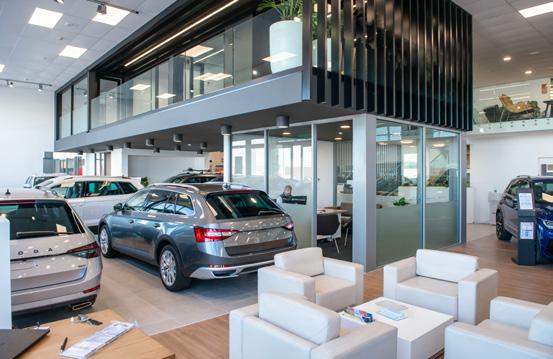
“It was also a chance to expand our central in-house cafe, which is utilised by customers and the general public.
“The whole area has been
modernised and now there’s a lot of natural light coming through. One challenge businesses face is keeping a showroom warm or cool, so we’ve installed air conditioning and the cafe has heated floors.”
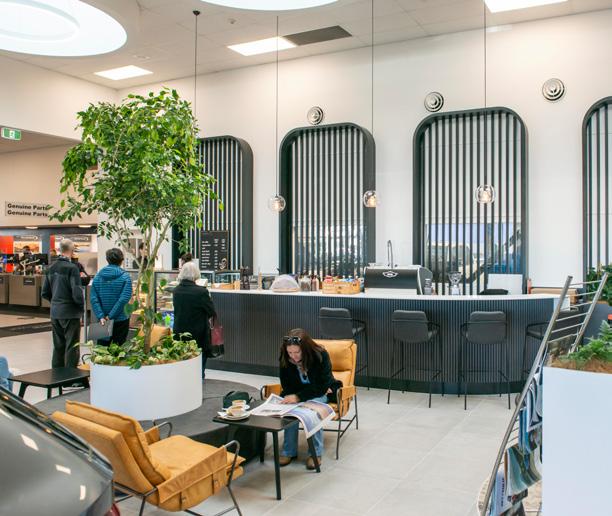
The commercial cafe seats about 40 people and Farmer says opening it to the public provides good exposure to the dealership.
“It’s never easy renovating a central area,” he adds. “But we screened off the main area for four months while the work was being done, and tried to keep all the noisy and dirty work for after hours when we didn’t have customers coming into the showroom.
“Now the work is finished, it looks magnificent. The central hub can be seen pretty much from most of the dealership’s showrooms. It gives the whole place a lift.”
20 www.autofile.co.nz news
TO FEATURE IN INDUSTRY MOVERS EMAIL EDITOR@AUTOFILE.CO.NZ
Farmer Autovillage’s cafe and, below, its Skoda facility
Ring in changes to boost sales
With the broad range of digital communication options available to customers nowadays, it would be reasonable to expect the humble telephone call is fast becoming a thing of the past.
Interestingly however, when it comes to the automotive industry, that couldn’t be further from the truth.
Our own data indicates more than 60 per cent of dealership enquiries in New Zealand are, in fact, from phone calls. This means that when it comes to buying and servicing a car, customers are keen to speak to a real person instead of via messages.
But what is unfortunate is that on average some 22 per cent of telephone calls are being missed or abandoned across our country’s dealership network. As a result, thousands of dollars a year in profit is being squandered as these unanswered prospective buyers are forced to take their business elsewhere.
So, what’s the solution? In regard to phone-call management, New Zealand’s top performing dealerships all have one thing in common – they have call-tracking systems in place.
Call tracking serves a variety
of purposes, each of which can improve efficiency in your dealership. In general, it’s relatively fast and simple to set up and cost-effective to run, particularly considering the benefits it delivers.
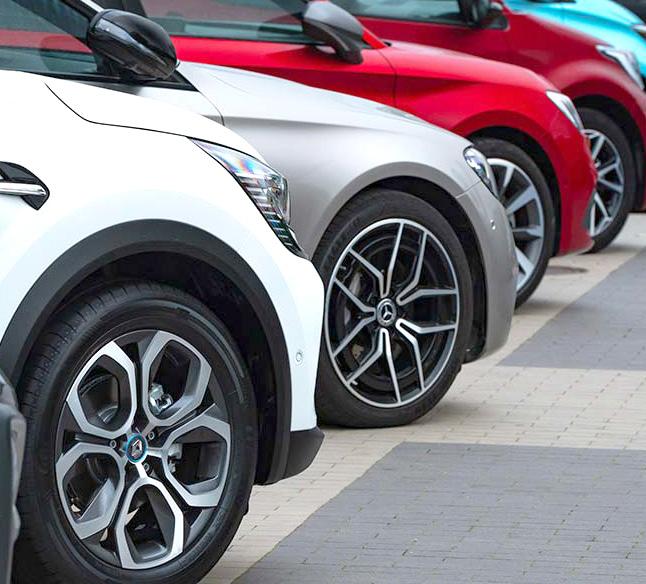
VISIBILITY OF CALLS
With the aid of an online dashboard, a tracking system will provide you with full visibility on your phone calls.

This means you can see how many you have received, how many were missed and where they originated. It can also provide recordings, so you know exactly what was said.
Once you have access to this information, it’s imperative to use it to your dealership’s advantage.
CALLER NOTIFICATIONS

Firstly, you must deal with missed and abandoned calls because these are costing you most heavily.
Many tracking systems will automatically send an SMS to customers whose calls have been missed. This message will apologise for not answering and assure them a staff member will soon contact them.
Receiving this type of
communication immediately after a missed call is more likely to dissuade a customer from seeking help elsewhere.
As part of the same process, a relevant member of staff should receive notification of the missed call, and contact the client as quickly as possible to maintain momentum from the enquiry.
Introducing such a process into a dealership can have a significant impact on your bottom line. As one prominent franchise dealer said to me about his tracking system, “the missed-call notification is worth the cost alone”.
SOURCE OF ENQURY
Understanding the origin of your enquiries is key to effectively managing your marketing budget.
A tracking system can tell you the source of a phone call – be it through a social-media campaign, Google search, display ad or even a newspaper advert.
This information can provide you with accurate insights into which advertising channels are driving calls to you, and in turn
enable you to direct your future advertising budgets accordingly to maximise your investment.
CALL RECORDINGS
Recordings that can be obtained from a call-tracking system are invaluable for dealers keen to develop their staff. All phone calls can be listened to after completion and utilised as training tools to improve your team’s sales skills.
Your provider can also make training recommendations and suggest where your team may need support based on customer sentiment analyses they can run on your calls. The recordings can also be used for later reference, for example, in dispute resolution.
Recently, a dealer principal in Auckland was able to use recordings to confirm his service manager hadn’t misquoted the price of a set of tyres. He was then able to quickly and cost effectively resolve the matter with his customer.
As a leading form of enquiry for most Kiwi dealers, the importance of phone calls shouldn’t be underestimated. Call tracking is an important tool for reducing costs, improving efficiencies and driving revenue. Can your business truly afford to be without it?

www.autofile.co.nz 21
Call (09) 887 1822 or email info@adtorqueedge.com | adtorqueedge.co.nz INVENTORY PRICING. NOW IN NEW ZEALAND! PRICE YOUR STOCK AGAINST THE MARKET INSTANTLY! ADTORQUE EDGE
TODD FULLER General manager, New Zealand AdTorque Edge
The month that was... December
December 7, 1998
Jail sentence sends warning to clockers
The result of a long-running court case, which ended the previous week, had sent a clear message to clockers of used imports.
Richard Mark Wallace, 40, was jailed for twoand-a-half years for conspiring to defraud potential buyers and forging 103 Japan Auto Appraisal Institute certificates.
The case had been running since 1996 when Wallace and two other defendants were charged with fraud offences in Auckland District Court.
One co-defendant, about whom the court said there was no suggestion of odometer tampering, and the third person were discharged without conviction but Wallace’s case had dragged on. He changed his plea to guilty just as the trial was due to start.
The Serious Fraud Office, which brought the charges, had hoped Judge Carol Shaw would hand down a six-year jail term.
Wallace’s defence counsel had wanted a suspended sentence because he hadn’t reoffended in the three years since the scam was first uncovered. At the time of the most recent offences, he was trading as a vehicle wholesaler.
The judge found Wallace was responsible for rewinding 115 cars with the total gained from his deception exceeding $124,000.
December 10, 2004
Gang terror for car dealers
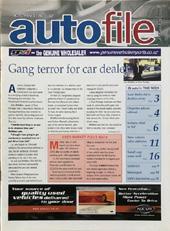

A group of gang-based “debt collectors” subjected a car-yard owner to blackmail, kidnapping and extortion, Christchurch District Court heard.
The trader told a deposition hearing that three men went onto his premises on April 26, 2004, demanding payment of a debt owed by a former employee.
“The best thing to do was to do whatever they said,” the dealer told the court. “I thought I was going to get murdered or smacked over, so I just did as I was told.”
The dealer’s ex-employee, who began an 18-month sentence for various fraud offences in July 2004, had one-and-a-half more years added to his jail time in October after admitting to his role in the raid.
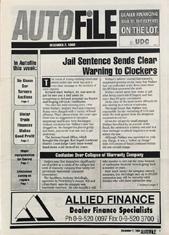
He had lent the trader $50,000 for new stock, but later defrauded the business and several customers.
The Black Power members who were appearing in court had locked the car dealer in his office during the incident, and forced him to write two promissory notes for $75,000 and a cash cheque for $5,000.
December 1, 2004
Industry against register restrictions

The board of the Motor Trade Association (MTA) was to meet the following week to discuss government plans to restrict access to the motor vehicle register (MVR).
The MVR was a hot topic with concerns being raised over the risks dealers would have to take should full histories of vehicles be unavailable to them.
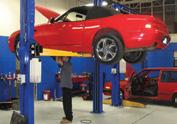
Harry Duynhoven, Minister for Transport Safety, said in response to a letter he had received against the proposal, that “in 2005/06 about 9.6 million records were downloaded electronically by businesses.“ He added: “There are also concerns about the use of register information for criminal purposes, such as stalking.”
Phil Bothamley, chairman of the MTA’s used-vehicles committee, said: “At present, dealers use systems like VIR [Vehicle Information Report] or Baycorp to get information off the register.
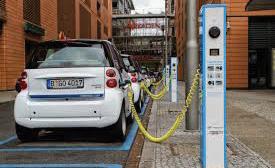
“Then we know if anyone has security on the car, what the current owner’s name and address are, and information on previous owners. It paints a proper picture of the vehicle’s history, which is vital.”
December 16, 2009
Grand designs for 2010
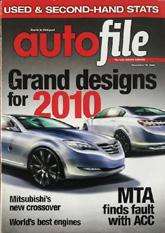
As New Zealand recovered from economic recession, vehicles sales were expected to pick up across all segments and some major changes to the industry were also predicted.
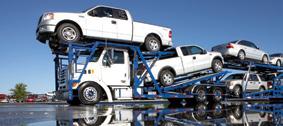

Not only would Chinese vehicles have a major impact on sales of new cars, it was anticipated that Malaysian manufacturer Proton would make a move into the New Zealand market after its huge success in Australia.
But South Korean manufacturers were not expected to simply sit back and watch new, cheap models coming onto their patches. Kia and Hyundai had dominated new sales in 2009 and would keep pushing to stay in the top 10, it was predicted.
Syed Zainal, managing director of Proton Holdings Berhad Group, said: “The driving force responsible for growing our domestic sales volume and market share has been our best-selling models – the Persona, Saga and Exora.
“As for export, this month we will be launching the Exora in Thailand, as well as the S16 in Australia and Egypt. Despite the challenges, the group believes sales volume prospects will be resilient.”
In addition to Proton’s expansion, a new segment was expected to open up after Hyundai’s flagship Genesis sedan was named “near luxury car” leader by a US-based research consultancy.
22 www.autofile.co.nz looking back Don’t go
Let
news
to you. Subscribe now to for twice-weekly updates www.autofile.co.nz/subscribe INSIGHT
searching for news.
the
come
Weight as important as emissions
The clean car standard (CCS) will soon come into effect with penalties beginning to accrue from January 1, 2023.
What has not been wellcommunicated is how the CCS will affect importers on a per-vehicle basis. This can be summarised based on the top 25 used models imported during September and October this year.
For example, 1,114 Toyota Aquas with the specific model code of DAA-NHP10, a 1,496cc rating and tare weight of 1,090kg topped the ladder. These vehicles attract a clean car discount (CCD) of $1,530 and a CCS credit of 32gCO2/km.
While I used all values from New Zealand’s motor-vehicle register as well as the Ministry of Land, Infrastructure, Transport and Tourism in Japan, it must be stressed that these figures are indicative only.
Unlike the clean car discount, which impacts on consumers, the CCS directly targets importers of motor vehicles.
The policy will charge penalties or provide credits based on the efficiency of cars being brought across the border. Penalties will be paid directly to the government, with credits being used to offset future charges or traded with other importers.
Also, unlike feebates, the CCS is weight-adjusted. This means stricter targets actually apply to lighter vehicles. Heavier vehicles have more lenient targets.
The “logic” behind this weight adjustment is that different original equipment manufacturers (OEMs) specialise in different sized vehicles
and the government feels there’s a need to put the pressure on all of them equally.
Personally, I think it’s a concession to the OEMs, which have already stated their intent to continue to sell bigger, more massive and more profitable models.
Whichever argument is correct, the scheme is weaker for it and the used-imports industry, which tends to bring in lighter and more efficient vehicles, will be hit harder
ratings:
for it. However, I know “we must save the utes”.
The trading of CCS credits is a commercial arrangement between importers. Waka Kotahi only provides the platform to store the credits and the functionality to conduct the trade.
It’s also important to mention that the exchanging of these credits will be subject to both GST and antimoney laundering obligations.
As an alternative, well-established companies can apply to the agency
to use an annual plan, which shifts the burden of paying these fees from per unit to once yearly.
This allows more strategic offsetting. But it is balanced by a slightly higher carbon unit or efficiency unit cost, which brings us to a point of confusion.
Our government has done a poor job of communicating the purpose of the plan and purpose of penalties. Calling them “carbon units” and having “carbon accounts” is confusing and misleading.

The purpose of the CCS and the clean car discount is to incentivise more efficient vehicles, not to pay for the carbon dioxide (CO2) emissions.
Prius DAA-ZVW30 1,797 1,350kg $1,430 41 n/a 288 Mazda Demio DBA-DEJFS 1,298 1,010kg $1,080 10 n/a 281 Toyota Corolla DAA-NKE165G 1,496 1,180kg $1,530 32 n/a 271 Toyota C-HR DAA-ZYX10 1,797 1,440kg $1,410 48 n/a 216 Nissan Leaf ZAA-AZE0 n/a 1,445kg $3,450 147 n/a 200 Mazda Axela DBA-BL5FW 1,498 1,250kg n/a -38 -$683.29 179 Nissan Leaf ZAA-ZE1 n/a 1,510kg $3,450 153 n/a
145
Mitsubishi Outlander PHEV DLA-GG2W 1,998 1,850kg $2,150 118 n/a
144 Nissan Note DAA-HE12 1,198 1,210kg $1,570 37 n/a
132 Toyota Sai DAA-AZK10 2,362 1,570kg $850 32 n/a 132 Mazda Axela DBA-BLEFW 1,998 1,340kg n/a -38 -$691.05 121
Toyota Prius DAA-ZVW41W 1,797 1,450kg $1,160 37 n/a 119
Toyota Camry DAA-AVV50 2,493 1,540kg $950 34 n/a 113
Toyota Prius DAA-ZVW30 1,797 1,310kg $1,510 42 n/a 103
Mazda Demio DBA-DJ3FS 1,298 1,020kg $1,060 9 n/a 100 Mazda CX-5 DBA-KEEFW 1,997 1,440kg n/a -15 -$269.67 91 Honda Fit DAA-GP1 1,339 1,130kg $1,180 15 n/a 88
Nissan Serena DAA-HFC26 1,997 1,660kg n/a -5 -$98.63 86 Honda Fit DAA-GP5 1,496 1,130kg $1,550 33 n/a 83 Subaru XV DBA-GP7 1,995 1,350kg n/a -24 -$423.91 81
Nissan Note DBA-E12 1,198 1,090kg $1,000 6 n/a 75
The units officially stored in a CCS account are in grams of CO2 per kilometre, but in reality they should probably be some sort of efficiency measurement that also references the mass of the model.
It’s most important for importers to remember that just because the feebate scheme rewards credits for any specific vehicle, this doesn’t mean the standard will also do this.
This is because the weightadjusted component of the CCS rewards heavier, less-efficient vehicles.
Mazda Axela DBA-BMEFS 1,997 1,310kg $500 -7 -$124.46 71
Toyota Hiace CBF-TRH200V 1,998 1,760kg -$2,875 -35 -$630.48
VIA stresses these numbers are indicative only. They are based on data from New Zealand’s motor-vehicle register and the Ministry of Land, Infrastructure, Transport and Tourism in Japan. Models with a minus in front of the dollar value means it attracts a penalty of that amount.
As soon as a calculator is available that allows us to look up specific models and see the impact of the CCD and standard combined, importers need to explore the range of vehicles that are available in Japan and consider their options carefully. But be warned, the CCS makes it much more complex than simply looking for the cars with the lowest emissions.
www.autofile.co.nz 23 tech report
KIT WILKERSON Head of policy and strategy kit@via.org.nz
Advise • Advocate • Connect www.via.org.nz Imported Motor Vehicle Industry Association Advocate Advise Connect
Total Make Model Model code CC rating Tare weight CCD credit CCS credit (gCO2/km) CCS penalty
Toyota
n/a 970
519 Toyota
CCS
Top 25 used imports (Sept to Oct 2022)
1,114
Aqua DAA-NHP10 1,496 1,090kg $1,530 32
Toyota Aqua DAA-NHP10 1,496 1,050kg $1,680 39 n/a
Ranger takes national title
Aute powered by fossil fuel has been named the 2022 AA Driven New Zealand Car of the Year despite increasing competition in the new-vehicle market from electric models.
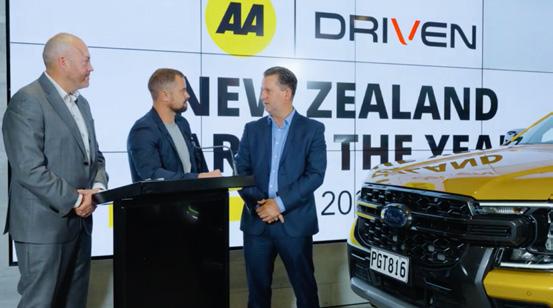

The Ford Ranger took out the overall prize and was also named best light commercial after judges described the latest version of the utility as being “as fit for purpose as ever”.
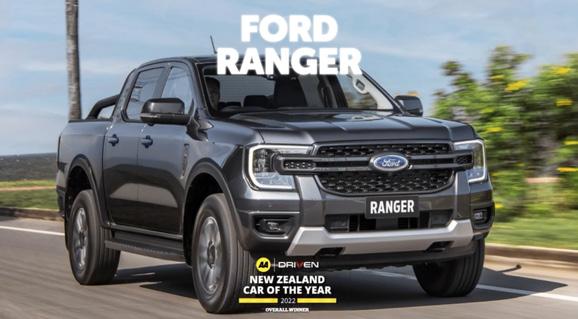
BYD’s Atto 3 and the Mitsubishi Outlander were also named in the top three overall.
Simon Rutherford, Ford New Zealand’s managing director, describes the win as “fantastic recognition” for the next-generation Ranger, especially against such a diverse field of competitors.
He adds: “It has really hit it out of the park when it comes to nextlevel refinement, capability and performance.
“We would like to thank all the Ford designers and engineers who have taken an already class-leading vehicle and managed to improve it, not by a few tweaks and adjustments but by leaps and bounds.”

The AA’s Jonathan Sergel, who was until recently its general manager of motoring services, says picking this year’s overall winner was a unanimous choice for the judges.
He says: “This decision was absolutely the right one, with the most efficient engine seen in the Ranger to date combined with a crowd-pleasing blend of car safety and ute practicality.”
Models launched in the past 12 months were the focus of the contest, but others on sale with five-star safety ratings were also considered.
Among the 30 judged finalists and 10 class winners, 24 offered some form of electrification –reinforcing the rise in demand for greener vehicles.
Dean Evans, Driven editor, says the Ranger is one of the most carlike and user-friendly utes on the market, and its latest round of
Award winners
Small SUV: MG ZS
Medium SUV: Kia Sportage
Large SUV: Kia Sorento
Hybrid: Toyota Highlander
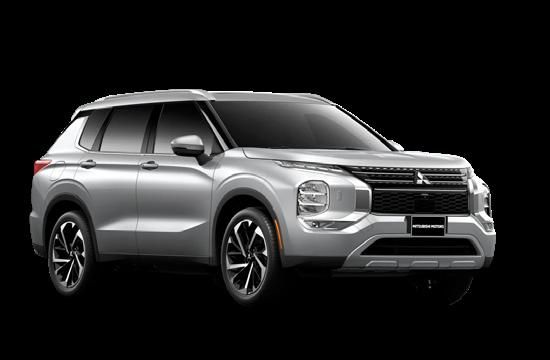
PHEV: Mitsubishi Outlander
BEV: BYD Atto 3

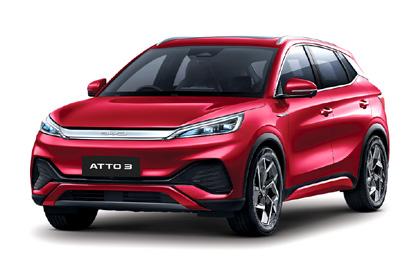
Passenger: Honda Jazz Sports and performance: Chevrolet Corvette Light commercial: Ford Ranger
Luxury: BMW iX
AA safest (based on Ancap testing): Tesla Model Y
People’s choice: Toyota RAV4
Overall top three: BYD Atto 3, Ford Ranger, Mitsubishi Outlander
Overall winner: Ford Ranger
shown a strong interest and increasing uptake in electric vehicles, Kiwis have proven their continuing love and need for utes.”
The people’s choice award was taken out by the Toyota RAV4, a repeat of its success in the same category in 2019, after more than 50,000 votes were cast.
24 www.autofile.co.nz news
We are looking for NZ
Ideally 2012 or newer with less than
If you have something you'd like priced, contact Jason: 0274 133 222 | jason.robb@southaucklandmotors.co.nz
new Fords and Mazdas.
150,000km
Simon Rutherford, right, of Ford NZ, with Jonathan Sergel, left, of the AA, and presenter Sam Wallace, of Driven
The 2022 NZ Car of the Year was chosen from a crop of 30 finalists
The BYD Atto 3, above, and Mitsubishi Outlander made this year’s top three
Year with plenty of challenges
What a year 2022 has been and what follows is a reminder of what we’ve been through in a rough chronological order.
Tougher loan-approval rules were brought in during the tail end of 2021 after a review of the Credit Contracts and Consumer Finance Act (CCCFA).
Most in the industry said the changes weren’t needed. Indeed, it would have been better for the government to have addressed the issue and simply exercised a bit of enforcement. Anyway, the changed legislation landed on the finance market – including for cars and homes – with an immediate decline in approvals.
The government then took until end of 2022’s first quarter to accept there were problems. Small changes were made in July to address some of the new CCCFA’s impacts with more planned for March 2023 when extra legislative revisions take effect. All up, it wasn’t a positive start to this year.
Part two of clean car discount landed on April 1. We could all see the impacts with March’s spike in high-emitting vehicles being registered followed by “clean cars” the next month.
This feebate scheme has proved to be less than smooth in the used-imports space with carbon dioxide (CO2) emissions data found
to be not as accurate as it could be. Plenty of time and energy was then exerted by the folk at Waka Kotahi as they scrambled to rectify errors and disputes.
The drain on staff resources at the transport agency reportedly impacted on planning for the soon-to-eventuate clean car standard (CCS), but more on that later.

The final emissions reduction plan landed in the second quarter of 2022. Thankfully, it didn’t include extra control measures on imports as initially proposed, such as setting a maximum vehicle CO2 limit. However, it did declare support for introducing a trial scrappage scheme. Planning is in progress on that front, so watch for more on that in 2023.
After a review of registered motor-vehicle trader fees was completed, a new schedule landed on August 1. The charges, although not big in the scheme of things, hadn’t been reviewed since 2004 when they came in.
As night follows day, it was entirely expected for traders to pay a bit more and so it was. It was a shame that the review’s scope was narrow. Perhaps a chance was missed to address related matters, not just the dollars.
Dealers’ access to private-owner name and address information on the motor-vehicle register was next up. After a brief “consultation”, revised rules were issued on November 1 along with updated five-year terms. It’s easy to assign to the “been there, done that” box, but there’s a sting in tale of this one.
The terms landed with a whole new set of compliance terms and conditions, which encompass declarations, training, tracking and reporting. Traders would be wise to take heed and set measures in place now, if they haven’t already, to comply.
Life might get ugly when the anniversary rolls around at the same time in 2023 and you’re unable to submit your annual access report or don’t have systems in place to confront an audit.
Lastly, the leading subject now is the impending CCS.
It’s on-track to launch on January 1 as originally planned, despite major delays in the development phases and industry calls for deferment.
Trials were originally planned to start in July or August, but were put off as the transport agency devoted much of its resources to
resolving data “hiccups” with the feebate scheme.

Now, in the final stages of planning and time available, information flow has been limited and sporadic as bits and pieces are progressively released. Importers were invited to open CO2 accounts from early November.
At the time of writing, Waka Kotahi was still awaiting sign-off of an interim manual tracking system given the originally intended automated IT-based system is still some months from implementing.
From January 1, new and used light vehicles – albeit with a few exceptions – will incur credits or debits when imported notwithstanding these will be based on a different calculation methodology than the clean car discount.
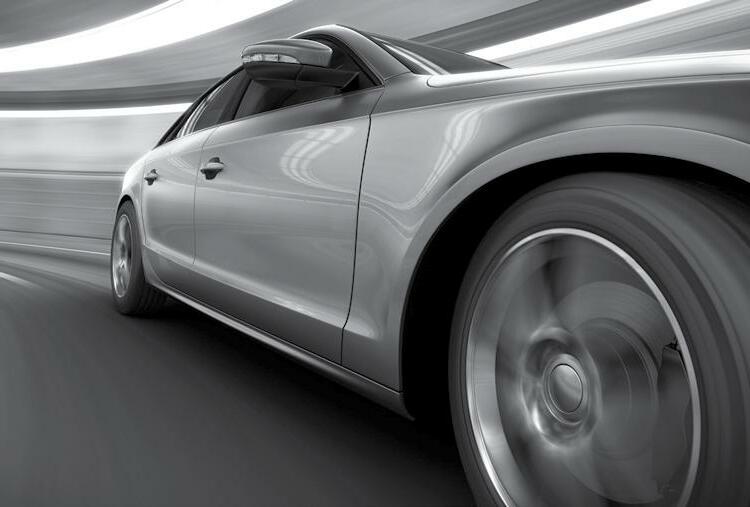
At this point, if you’re feeling a little breathless that’s reasonable. And I haven’t even mentioned the market and all that came at you from that direction – including the tail-end of Covid-19, staff shortages, rising prices, product shortages and the Russians grabbing a big chunk of Japan’s used stock.
All I can say at this point is have the best break you can over the festive season because 2023 will likely bring more challenges. But given you’re still around and reading this, you know you’re up for it.
HELPING DRIVE YOUR BUSINESS The MTA brand is consistently associated with expertise, reliability and trust. Talk with us today about the benefits of MTA membership. mta.org.nz | 0800 00 11 44
TONY EVERETT Sector manager – dealers, Motor Trade Association
Setting ‘pure sports’ credentials

Honda is describing its next-generation Civic as the most powerful model in the Type R brand’s 30-year history.
It combines “potent” dynamic performance with an immersive cockpit experience and muscular design.
Now entering its sixth iteration, 2023’s more powerful hot hatch recently set a front-wheel-drive production-car track record at Formula One Suzuka circuit.




By advancing the concept of its predecessor the Ultimate Sport, the all-new model has been developed to achieve “pure sports performance”.
Honda’s engineers have conducted extensive development in Japan and rigorous testing at tracks around the world to further improve the Type R’s chassis.
Under its vented aluminium bonnet is a more powerful version of the marque’s K20C1 engine. Power, torque and response are improved by a redesigned turbocharger, increased air-intake flow rate and a more efficient exhaust system that features a straight-through design.
The turbocharged two-litre
four-cylinder now produces 235kW of power and 420Nm of torque – up by 7kW and 20Nm over the previous model.

A bigger grille opening and radiator, along with a largediameter fan, improve engine cooling to ensure sustained and optimal performance during extreme driving. The active exhaust valve opens at higher rpm to enhance engine sound.
The precise six-speed manual transmission is further improved for an “even more rewarding connection” with the driver.
A lighter flywheel and a revised rev-match system ensures “perfectly paired” rev-matching when shifting down gears to help maintain stability on corner entry. The

gearbox has gained a high-rigidity lever and optimised shift-gate pattern for hyper-precise changes.
The Type R’s sharp responses have been increased by a significantly more rigid body structure, which supports improved dynamics and refinement. The wheelbase has been extended for greater stability, while the front and rear tracks are much wider.
Together with a retuned dualaxis strut front and multi-link rear suspension, these changes improve straight-line stability and steering feel.
Drivers can switch between four pre-set performance settings, selecting different modes for the engine, steering, suspension and engine sound. In addition to comfort, sport and +R, a new “individual” mode enables customised motoring.
The Type R’s digital meter display features clean graphics. incorporating a large tachometer, and gear-position and multiinformation displays.
A second new meter design is exclusive to the +R mode.
This allows the driver to obtain information instantly with the engine’s rpm and gear position placed at the top.

Exclusive to the Type R, an enhanced version of the Honda LogR performance datalogger combines the onboard computer and sensors with a built-in app. This helps monitor and record performance parameters in real time when driving on-track.
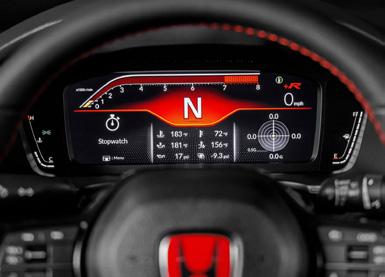
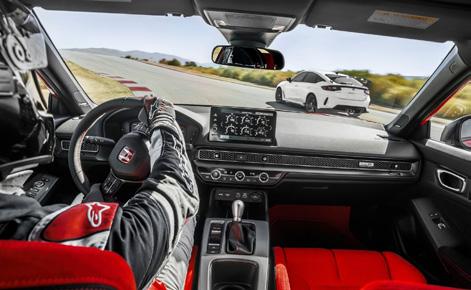
The new Civic, which is is priced from $69,000 plus on-road costs in New Zealand, boasts a sleeker look. Its exterior is more aerodynamically efficient, generating significantly more downforce.
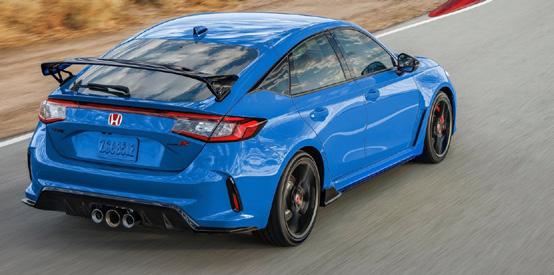
There are integrated flared wheel-arches over wider tracks and lightweight 19-inch matte black alloys wrapped in wider Michelin Pilot Sport 4S tyres.
All body panels forward of the A-pillars are unique to the Type R, including a new and more aggressive front-bumper. Its lower stance is accentuated by wider rear doors and a reshaped rear bumper that reveals its updated, signature three round exhaust outlets.
26 www.autofile.co.nz
To advertise here, contact: advertising@autofile.co.nz or ph 021 455 775 VEHICLES WANTED DEALERS BUYING NOW Automotive excellence since 1993. Your o cial Audi, Porsche, Jaguar, Land Rover and Volvo dealer Wellington 66 Cambridge Terrace, Te Aro, Wellington | 04 887 1306
new cars
A redesigned rear spoiler with aluminium stanchions and a rear diffuser intensify downforce and reduce drag
The Type R features meters and gauges to bolster driver and vehicle performance
Securing provenance for the future
Everrati Automotive has revealed its electrified Porsche 911 (964) Wide Body Cabriolet – the first of its kind on the planet.
Bringing together zero-emissions motoring with iconic design, the company’s latest model boasts an electric vehicle (EV) powertrain of original equipment manufacturer (OEM) grade.
It says its wide-body cabriolet can deliver super-car levels of roofdown performance year-round.
Extensively engineered at the company’s headquarters in Oxfordshire, England, this Porsche combines a full restoration with the installation of sector-leading IP blended with technology from tier-one automotive suppliers.

As well as the UK and Europe, another key market for the addition to its range is the US where Everrati has a partnership
with the Aria Group. Based in California, Aria has expertise in low-volume, high-end engineering and production supporting world-leading OEMs. The venture enables 964 manufacturing on both sides of the Atlantic.
With more than double the output of the original Porsche 911 (964) Cabriolet on which it’s based, this wide-body model is available in 328kW and 373kW forms.

The latter can accelerate from
Icon’s green aim
Jeep has plans for its nextgeneration 4xe vehicles to be part of a transformation for it to become the world’s “leading electrified SUV brand”.
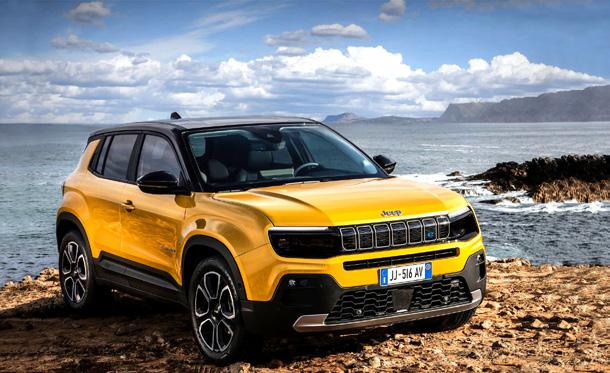
The aim is to introduce allelectric models in North America and Europe by the end of 2025 with other markets to follow.
The all-new Recon and Wagoneer are destined for North America and other regions, with the Avenger launching in Europe early next year.
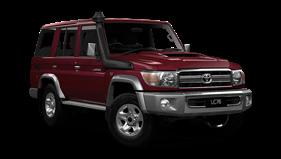
The Recon will boast Jeep’s Selec-Terrain traction management system, e-locker axle technology, under-body protection, a onetouch powertop, removable doors and glass, and the latestgeneration Uconnect system.
The Wagoneer will expand Jeep’s presence in the premium SUV segment. It will target a single-charge range of 645km and a 0-96kph time of around 3.5 seconds.
With an exterior design marked by a signature LED-lit grille, it’s driven by aerodynamic efficiency.
The all-new Avenger is a compact SUV that will also be sold in Japan and South Korea, and will be positioned under the Renegade.
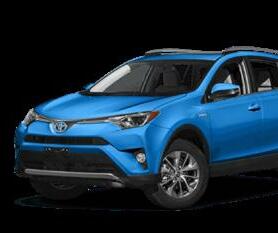
With a targeted range of 400km, it offers impressive ground clearance, breakover and approach angles for its segment, while also delivering a technologically advanced interior with plenty of space.
0-96kph in less than four seconds and has a range of 322km thanks to its 62kWh battery.
Everrati has worked to preserve the original “feel and character” of the Porsche 911 (964) Cabriolet by optimising weight distribution, chassis response and safety, and by enhancing the original’s performance. With its optional fully adjustable TracTive suspension system, a variety of modes can be selected.
This 964 uses a donor chassis and body – selected for its provenance and condition – as the basis for restoration and electrification.
At the core of Everrati’s engineering philosophy is the ability to fully reverse all modifications, allowing owners to revert the car back to its original specification if desired, and to preserve provenance into the future.
Its current line-up includes the Porsche 911 (964) Coupe, Targa, the Cabriolet in Pure, Signature and officially licensed Gulf Signature Editions, the Land Rover Series IIA, GT40 in partnership with Superformance including the officially licensed Gulf Edition, and the Mercedes-Benz SL Pagoda.
Everrati was founded in 2019 by British entrepreneur Justin Lunny and long-term automotive specialist Nick Williams.
www.autofile.co.nz 27
new cars
Looking to buy late model NZ N ew cars, SUVs and commercial vehicles VEHICLES WANTED Contact Paul Curin P. 0274 333 303 | E. pcurin@milesgroup co.nz
Jeep’s Avenger
Everrati’s electrified Porsche 911 (964), a wide-body cabriolet
Kiwi gets ‘job done’ in Bahrain

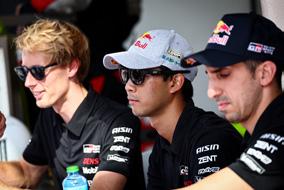
Toyota Gazoo Racing (TGR) earned a dominant one-two victory in the season-ending 8 Hours of Bahrain to secure a clean sweep of FIA World Endurance Championship (WEC) titles.
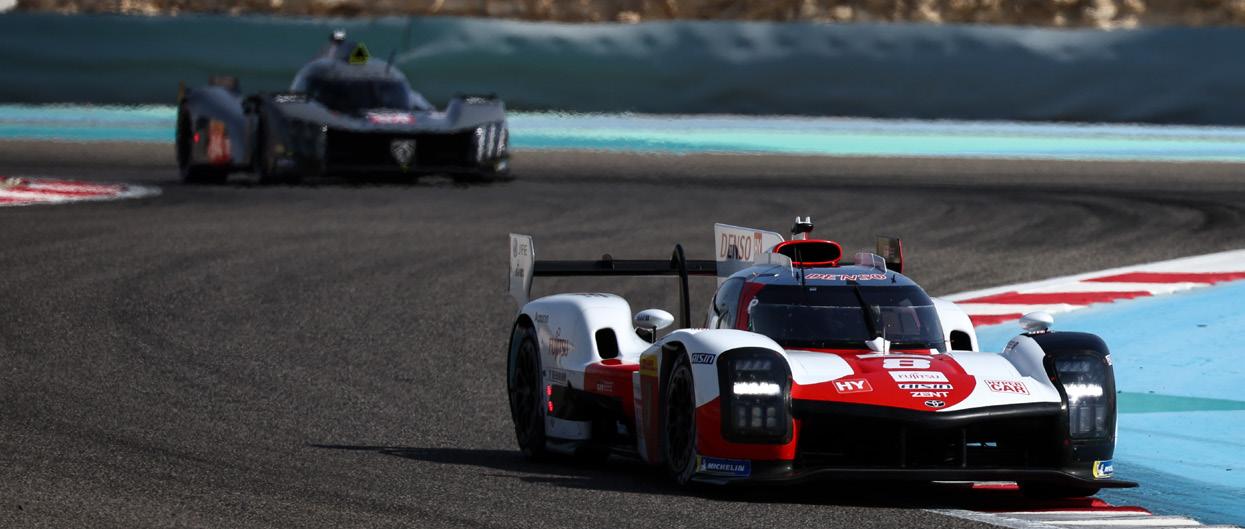
Outgoing world champions Mike Conway, Kamui Kobayashi and Jose Maria Lopez took a hard-earned win, their second of 2022 in their GR010 Hybrid to cement TGR at the pinnacle of the manufacturers’ ladder.

Sebastien Buemi, Brendon Hartley and Ryo Hirakawa, racing in car number seven, started the final round level on points with their Alpine title rivals. They finished second to take out the drivers’ world title, adding to their Le Mans 24 Hours win earlier this year.
“I’m really pleased to complete the job here and win both championships,” says Hartley.
“Thanks to everyone on the team for their support all year to give us a car to win the drivers’ title and Le Mans.
“Our objective was to beat Alpine and secure the manufacturers’ title, so we couldn’t afford to take any risks just to get the win. They had the pace and deserved victory, so well done to them.”
Buemi and Hartley’s names now enter the record books as the first racers to land three titles in the top category of the WEC or its predecessor, the World Sportscar Championship.
Hirakawa, a winner at Le Mans in June, ended his rookie season finishing up as Japan’s third WEC champion.
A perfect result in Bahrain was a fitting end to a successful season for TGR, which now has a fifth world-championship double from a decade in the WEC.
It has achieved the unique feat of winning every available title, a total of eight, in the three FIA series it competed in this season – the WEC and World Rally and World Rally Raid championships.
The top six in Bahrain was 1st: TGR #7, 245 laps, 2nd: TGR #8 on plus 45.47 seconds, 3rd: Alpine Elf Team #36 (Negrao, Lapierre, Vaxiviere) on plus two laps, 4th: Peugeot TotalEnergies #94 (Duval, Menezes, Muller) on plus six, 5th: WRT #31 (Galael, Frijns, Vanthoor), plus eight, 6th: United Autosports USA #23 (Lynn, Jarvis, Pierson) on plus eight.
TEENAGERS’ CHALLENGE
Back home, and a successful shootout for William Exton and Tom Bewley at the Hampton Down NZ Racing Academy guarantees both will be part of the 2023 Toyota 86 Championship.
As the grid for the season takes shape, 18-year-old Exton and Bewley, aged 15, are exciting additions to the six-round series, which kicks off at Highlands Motorsport Park on January 13.
Exton topped the three-way shoot-out in north Waikato last month, bagging a cash prize of $37,500 from the Tony Quinn Foundation towards his Toyota 86 season.
Bewley was hot on his heels and his $10,000 prize also locks in his grid spot for 2023.
Third-placed Cormac Murphy,
another significant prospect for the future, impressed and has secured more time at the academy to hone his skills.
Exton, of Blenheim, has already raced a Toyota 86 in two endurance events to get mileage under his belt as he switches to circuit racing from an impressive six-year career in karting.
That run of success included championship wins in 2017 in a 100cc Junior Yamaha in the Kartsport NZ South Island Championship and schools champs. He then repeated that feat in 2019.
Last year, he was Kartsport NZ National Sprint champion in the Rotax Max Light class. A long list of victories and top three finishes
in other series single him out as a special talent.
Although three years younger, Bewley is another sensation having never finished outside the top three in karting championships he’s competed in.
Since 2016, he was crowned as number one in the Rotax Junior class in Kartsport’s North Island Sprint series in 2020 and this year’s Auckland City of Sails face-off.
Exton and Bewley have impressed motorsport legend Steve Horne, who judges the shoot-out for the Tony Quinn Foundation.
As a team manager and then an owner, Horne took out the Indianapolis 500, two
28 www.autofile.co.nz motorsport
Sebastien Buemi leads the field at the start of the 8 Hours of Bahrain
Brendon Hartley celebrates qualifying in pole position
2022 WEC world champions. From left, Brendon Hartley, Ryo Hirakawa and Sebastien Buemi
Championship Auto Racing Teams championships and five Indy Lights titles, so it’s safe to say the Kiwi knows talent when he sees it.
“First of all, every one of the finalists did exceptionally well to make it that far from a group originally probably more than 70 strong,” enthuses Horne.
“They went through a threephase process, which I often refer to as the ‘three-legged stool’. Those legs are performance on the track, technical and engineering skills off it, and understanding the sport’s commercial side.”
Their track time essentially mirrored a race day with 10 laps of familiarisation, 10 for qualifying and then a race simulation for 10 laps.
“What I noticed about William and Tom was they were up to speed and on the gas immediately,” adds Horne. “For me, that has always been a good sign with any driver. I saw it in my Indy Lights team with Helio Castroneves and Tony Kanaan, and I’ve seen it with many others too.
“Both lads were able to communicate well with engineers, interpret changes in the car and work on improving its set-up.
“Commercially, William has already raised money for his sport in Blenheim and edged Tom on
experience in that regard. Tom’s younger and I feel he will develop the commercial skills if he keeps improving at the rate he is.
“Overall though, they are impressive and will be great to watch them in the Toyota 86.”
Exton and Bewley will now knuckle down to testing their 86s to ensure they are at the grid’s sharp end when the series starts in the new year.
They are exciting prospects for TGR NZ motorsport manager Nicolas Caillol too, who has seen some amazing talent in the series over the past few seasons.
He says: “We’ve seen plenty of talent emerge from karting and use the Toyota 86 as a springboard for international campaigns. Just look at former champions Ryan Wood and Callum Hedge, who are on the radar of all major teams in Australia and doing very well in Porsche racing.

“For us at TGRNZ, we’re always looking forward and ensuring the championship does its bit for finding New Zealand’s next world champion.”
AIMING FOR TOP EIGHT
Tayler Bryant has confirmed he will run for his third season in the Toyota 86 Championship.
Bryant, who hails from Pukekohe, south of Auckland, once again carries the support of MTF Finance on his car, which will be run by Action Motorsport as part of its multi-vehicle operation.
Following on from his debut season with the CareVets Scholarship Programme, Bryant won the first mini-endurance series during the coronavirus pandemic with Daniel Gaunt. He then had one season before taking a break, but kept up to speed by working in the pits.
He was back in the 86 category for the non-championship round at the Pukekohe Supercars meeting in September where he notched up impressive practice laps before qualifying ninth.
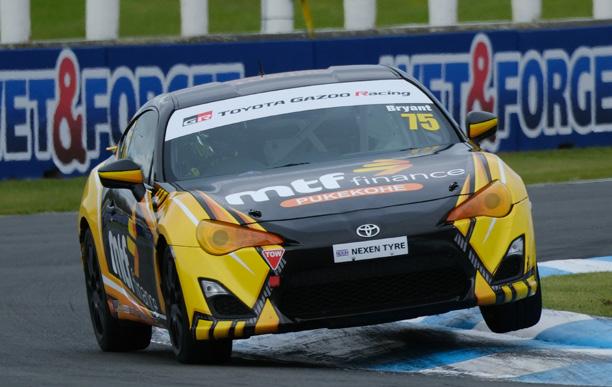
“It was awesome to be back for the Supercars when I had good
14-16 Circuit Chris Amon, Manfeild
pace, and enjoyed the vehicle and the close racing,” says Bryant.

“This year the competition will be difficult and there are a few things I need to work on if I want to keep up with the front pack. I would love to grab a few podiums, but my target is being a consistent topeight runner and to go from there.”
GRASSROOTS ACTION
Kevin Ingram got his 2022/23 SAS Autoparts MSC F5000 Tasman Cup Revival Series off to a superb start with a win from pole to chequered flag in the new season’s first race at the big MG Classic meeting in Feilding on November 10.
He set a best lap in the category’s qualifying session early on the Saturday morning.
Ingram then stormed away from fellow front-row starter Tony Galbraith and the rest of the 12-strong field to cross the finish line well-ahead of third-quickest qualifier Glenn Richards, who won his race-long battle for second place with Galbraith on the final lap.
www.autofile.co.nz 29
09 966 1779 www.jevic.com S P E C I A L I S T S I N PRE‑SHIPMENT INSPECTIONS MPI biosecurity inspections Biosecurity decontamination Heat treatment Odometer verifications Pre-export appraisals NZTA border inspections ? Lost documentation reports t motorsport
F5000 driver Kevin Ingram
86 2023 Toyota 86 Championship Date Location 1 Jan 13-15 Highlands
2
3
4
5
6
Hampton Downs’ shoot-out day for the Toyota 86 Championship saw William Exton, centre, and Tom Bewley, right, win big, while Cormac Murphy confirmed he’s yet another future prospect
Tayler Bryant in his MTF Finance-sponsored Toyota
Motorsport Park, Cromwell
Jan 20-22 Teretonga Park, Invercargill
Feb 3-5 Hampton Downs, Waikato
Mar 17-19 Taupo International Motorsport Park
Apr
TBC TBC
Adjudicator rules in dealer’s favour after car’s corrosion was ‘properly repaired’
Background
Trevor Clark purchased a 2011 Mazda Axela for $10,750 from Nova Motors Penrose Ltd on July 9, 2021.
He wanted to reject the car because it had pre-existing rust and was fitted with snow tyres, which Clark considered unsuitable for use in New Zealand.
The windscreen also had a crack, which he believed was caused by the vehicle’s structural integrity being affected by the underbody corrosion.
Clark wanted to recover the purchase price, and the cost of replacing tyres and what he incurred in pursuing his claim.
Nova Motors Penrose said his application should be dismissed because the Axela had been repaired and was in an acceptable condition when it was sold.
The case
The trader imported the vehicle from Japan in April 2021. It failed initial compliance due to rust.
Clark provided correspondence with Waka Kotahi confirming it was marked as damaged and specialist certification was required for any repairs.
The rust was treated by Epsom Vehicle Repairs in June and the car passed compliance testing on June 30.
When Clark inspected the car before buying it, he wasn’t told it had undergone corrosion repairs.
Soon after purchase, he noticed it had winter tyres, which he considered to be unsafe but the trader refused to replace them.
On July 13, he was told by a mechanic the vehicle had been treated for underbody corrosion. Clark contacted the trader and tried to reject the vehicle, but the dealer didn’t accept it.
He then had the Mazda assessed by AA Motoring, which found evidence of surface rust around the engine bay on the fixings and bolts, and recommended treatment on the affected areas.
buyer’s concerns over the winter tyres. It found they were fit for purpose, durable and safe, and complied with NZTA and warrant of fitness requirements.
Although they weren’t optimal for use in most New Zealand conditions, the tyres didn’t breach the CGA’s guarantee of acceptable quality because they met requirements for standards.
However, the buyer’s main concern was the underbody rust, the extent of which when the car was imported was unclear.
Nova Motors Penrose provided photographs of the affected areas taken after it had been repaired. Clark supplied photos taken after the hearing. Both sets of pictures showed the corrosion had been properly treated and repaired.
If the car had significant structural rust, it would have been flagged as “imported as damaged” by the border inspector and that flag would remain with the Mazda throughout its life.
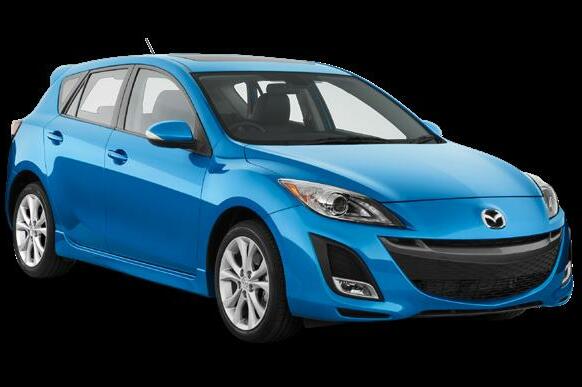
Neither party produced evidence to show this had been the case, so the adjudicator concluded the corrosion was surface rust that didn’t affect the Mazda’s structural integrity.
The tribunal’s assessor advised the treatment applied to the car’s underside by the repairer would significantly slow surface corrosion and there should be no major structural-rust problems to the underbody for many years.
The windscreen had cracked post-purchase. The cause was unknown, although the absence of
a chip in it suggested the problem had been caused by pressure being placed on it.
Clark believed the windscreen cracked due to the vehicle’s structural integrity being compromised by corrosion.
Given the finding that the rust was present when the vehicle was imported hadn’t affected the car in that way, the tribunal wasn’t satisfied this was the cause for the cracked windscreen. Furthermore, it couldn’t be satisfied this problem breached the CGA’s guarantee of acceptable quality.
Consequently, the adjudicator was satisfied the Mazda was of acceptable quality because it was as free of minor defects and as durable as a reasonable consumer would consider acceptable.
The tribunal then considered if the trader had engaged in misleading conduct that breached section nine of the Fair Trading Act (FTA) by describing the vehicle as a “grade four” import and by failing to disclose it had pre-existing rust.
Used cars offered for sale by auction in Japan are assessed by the auctioneer and are typically assigned a grade, with grade-one vehicles being of the lowest quality and five the highest.
Clark was told by the trader the Mazda was grade four. But he considered that was misleading because of its condition. Particularly, the pre-existing rust meant it was of lower quality than he would expect from a grade-four import.
The dealer provided a copy of the car’s Japan auction sheet,
The case: The buyer wanted a refund for his 2011 Mazda Axela after he discovered it had rust, a cracked windscreen and winter tyres. The trader refused to accept the rejection under the Consumer Guarantees Act (CGA). It contested the surface corrosion had been properly repaired, and the car was in an acceptable condition for its age and mileage when supplied.
The decision: The tribunal agreed with the dealer so the buyer’s application was dismissed.
At: The Motor Vehicle Disputes Tribunal, via video link.
which showed it had been assessed as grade four.
Consequently, by accurately passing on the grade information to Clark, the trader hadn’t engaged in misleading conduct.

Clark also claimed the dealer was obliged to disclose the car had pre-existing rust. That aspect of his claim required the tribunal to consider the extent to which non-disclosure or silence can be a breach of section nine of the FTA.
Under the common-law principle of “caveat emptor”, basically “buyer beware”, a claimant must show the other party has made a positive representation before it can succeed in any claim.
Silence or the failure to disclose a material fact cannot give rise to a claim. However, the principle of caveat emptor had been displaced by the FTA. Under this act, silence or failure to disclose a material fact can constitute misleading or deceptive conduct.
Nova Motors Penrose was only obliged to disclose the vehicle had been treated for corrosion if that information was so material that a reasonable consumer would have expected it to be disclosed.
In this case, the car didn’t have “imported as damaged” status, the corrosion wasn’t structural and it had been properly fixed. The tribunal didn’t consider Nova Motors Penrose had any obligation to disclose that the car had repairs for rust.
Order
The application was dismissed.
disputes 30 www.autofile.co.nz
A 2011 Mazda Axela
disputes
Trader loses case because tribunal rules legislation on contracting out breached
Background

Kishori Lal Uniyal bought a 2012 Toyota Aqua from 2 Cheap Cars on October 10, 2021, for $8,369 through his company Kritika Enterprises.

Two months later, it was inspected. Its hybrid battery was found to be faulty and needed replacing.
The trader declined to do so it because the vehicle was purchased for commercial use and both parties had contracted out of the CGA.
The case
The tribunal first addressed the car being bought by a company for commercial use and if this allowed the trader to avoid its CGA obligations.
Under section 43, contracting out is generally banned. However, a limited exception is offered after a change was made to the legislation in 2014 to mirror the equivalent provision in the Fair Trading Act (FTA).
The amendment means the focus is now on whether parties are in-trade rather than if the consumer buys a car for business purposes as was previously the case.
It’s the tribunal’s experience many traders are unaware the CGA changed or they haven’t been advised how to apply it now.
The first requirement for contracting out is for this to be done in writing. In this case, both parties signed standard-exclusion clauses in the vehicle offer and sale agreement (VOSA).
Uniyal bought the Aqua to commute to work and for workrelated deliveries. The trader’s general manager of operations, Dayton Howie, told him there were tax advantages for the company by purchasing the car through Kritika Enterprises.
The adjudicator considered that combination of factors established the vehicle was acquired in-trade as well as by all parties to the agreement. It was satisfied they had contracted out
because of the VOSA’s wording.
However, Uniyal claimed he didn’t realise the CGA wouldn’t apply. If he had been aware its provisions were excluded, he said he would have purchased mechanical breakdown insurance (MBI) but it wasn’t offered.
The ruling
At the hearing, the tribunal was concerned Uniyal’s English wasn’t adequate for him to understand what he had signed because he used a Hindi interpreter.
If Uniyal had established he was misled about the exclusion clauses and that was compounded by his lack of English, then that could provide a basis for arguing Kritika Enterprises didn’t agree to exclude the CGA.
Howie said Uniyal had a friend interpreting for him at time of sale. He added if Uniyal knew about MBI, he was likely to know about insurance products sold by the trader.
Overall, the adjudicator didn’t think there was enough evidence to establish Uniyal didn’t understand what he was signing.
The tribunal then considered if it was fair and reasonable the parties were bound by their agreement to contract out of the CGA.
It considered there was an imbalance in the bargaining power between Kritika Enterprises and the trader. The VOSA was standard form and its terms weren’t subject to negotiation.
Moreover, 2 Cheap Cars was a large trader but Kritika Enterprises was a small business that didn’t have the same experience in negotiating vehicle sale-and-
The dealer’s finance consultant, Anne Plaza, told Uniyal that because the Aqua was being bought in his company’s name that he would need to sign the VOSA’s exclusion clause.
She asked Uniyal if he was sure he wanted to buy the car in his company name because there were some disadvantages in this. Plaza explained that by signing the exclusion, Kritika Enterprises couldn’t make CGA claims.
As far as he remembered, Uniyal said no staff member explained the act’s application, but confirmed Plaza offered him the chance to get MBI.
Based on this, the adjudicator concluded Kritika Enterprises wasn’t given any opportunity to negotiate the VOSA’s terms for excluding the CGA.
It was clear the trader wrongly assumed if a company purchased a vehicle, then it was entitled to insist the company signed its exclusion clause. That indicated to the adjudicator the dealer didn’t know the CGA’s contracting-out law had changed.
In conclusion, given the parties’ imbalance in bargaining power and lack of evidence Uniyal knew the law gave Kritika Enterprises the ability to choose to contract out, the tribunal considered it was fair and reasonable for the company to be entitled to CGA protections.
As the trader had purported to contract out, it had – on the face of it – committed an offence under the FTA because misleading consumers as to their rights under the CGA can cause them to suffer losses.
The case: Around two months post-purchase, the hybrid battery in a car failed. The trader refused to replace it because both parties had contracted out of the Consumer Guarantees Act (CGA) when the buyer’s business bought it. However, a law change made in 2014 means the tribunal can overturn such an exemption if it’s deemed to be unfair and unreasonable.
The decision: The tribunal ruled the legislation applied to this case and ordered the dealer to replace the battery.
At: The Motor Vehicle Dispute Tribunal, Wellington.
The tribunal was disappointed a large trader was relying on standard-form provisions rather than negotiating CGA exclusions on a case-by-case basis.
Since the law was amended, parties who are in-trade and agree to contract out only have that agreement upheld if the tribunal concludes it’s fair and reasonable they are bound by it.
The tribunal agreed with the Motor Trade Association saying: “The consequences of contracting out must be fully disclosed to the purchaser – with evidence in writing to that effect being useful – and ideally the consumer should be encouraged to seek legal guidance. Written evidence to that effect would be wise and a separate form setting out these steps would help.”
It then considered the application of the CGA to this case. Prior to sale, the trader provided Uniyal with a test report dated September 30, 2021, stating the Aqua had a “good battery”.
There was no dispute it was defective, needed to be replaced and the problem arose about two months post-purchase, so the car didn’t comply with the guarantee of acceptable quality.
Orders
The trader had to replace the hybrid battery with a reconditioned one with a 12-month and 80,000km warranty, and pay Kritika Enterprises $50 for a battery scan.
www.autofile.co.nz 31
A 2012 Toyota Aqua
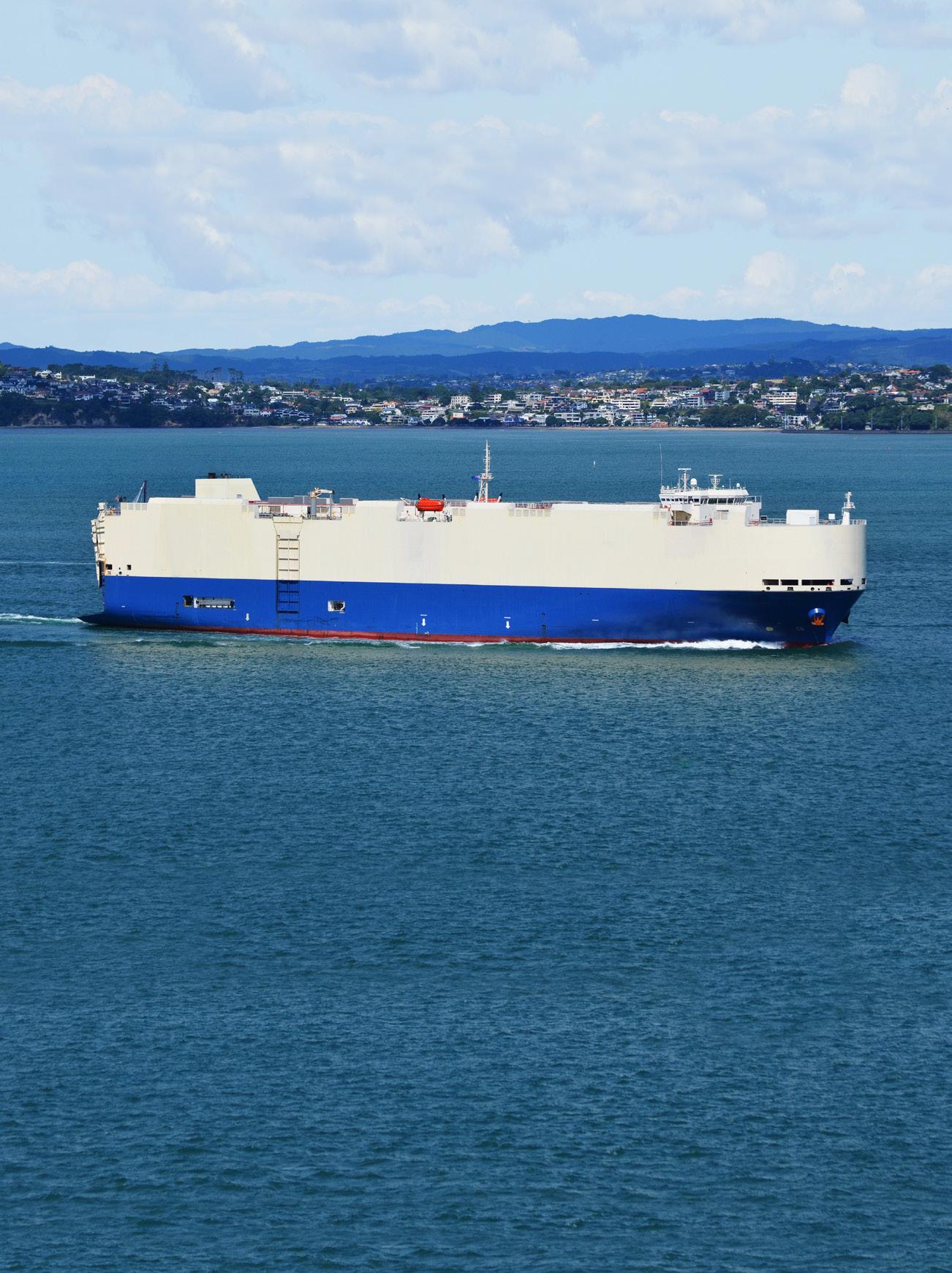


32 www.autofile.co.nz Phone 0800 ARMACUP (0800 276 2287) email enquiries@armacup.co.nz www.armacup.com Shipping to Port Calls Paglia v2223 Morning Cherry v2301 Moji Osaka 11 Dec 2 Jan Nagoya 12 Dec 3 Jan Yokohama 13 Dec 4 Jan Hitachinaka Auckland 27 Dec 17 Jan Lyttelton 31 Dec 28 Jan Wellington 2 Jan 30 Jan Nelson TBC 31 Jan LATEST SCHEDULE JAPAN NEW ZEALAND
NORTHLAND


OTHERS (Chatham Islands, overseas, unknown)
NEW: 2021: USED: 2021:
NEW: 2021: USED: 2021:
AUCKLAND
BAY OF PLENTY NEW: 2021:
USED: 2021:
GISBORNE NEW: 2021:
USED: 2021:
HAWKE ’S BAY NEW: 2021: USED: 2021:
USED:
NEW:
USED:
OTAGO NEW: 2021: USED: 2021: SOUTHLAND WAIKATO NEW: 2021: USED: 2021: TARANAKI NEW: 2021: USED: 2021: NELSON NEW: 2021: USED: 2021: TASMAN NEW: 2021: USED: 2021: WEST COAST NEW: 2021: USED: 2021: 281 269 372 485 24.5% 44.5% 1,818 1,086 1,451 1,816 25.3% 40.2% 34 31 20 55 70.0% 43.6% 53 34 76 61 30.3% 44.3% 65 55 65 104 0.0% 47.1% 85 86 72 138 18.1% 37.7% 933 539 1,239 935 24.7% 42.4% 325 211 477 382 31.9% 44.8% 183 76 231 171 20.8% 55.6% 236 137 328 237 28.0% 42.2%
759 579 893 814 15.0% 28.9% 5,493 3,429 4,818 4,982 14.0% 31.2% 213
Whangarei Auckland Hamilton Thames Tauranga Rotorua Gisborne Napier New Plymouth Wanganui Palmerston North Masterton Wellington Nelson Blenheim Greymouth Whangarei Auckland Hamilton Thames Tauranga Rotorua Gisborne Napier New Plymouth Wanganui Palmerston North Masterton Wellington Nelson Blenheim Greymouth Westport Christchurch Timaru Oamaru Dunedin Invercargill Whangarei Auckland Hamilton Thames Tauranga Rotorua Gisborne Napier New Plymouth Wanganui Palmerston North Masterton Wellington Nelson Blenheim Greymouth Whangarei Auckland Hamilton Thames A R OUND T H E COUNT R Y November 2022 7,156 2021: 11,321 36.8% Total imported used cars 11,176 2021: 11,222 0.4% Total new cars FINANCE TO SHIFT Y OUR BUSINESS I N TO TOP GEAR Your Vehicle Import Finance Specialist To find out more visit us at www.blackbirdf і nance.co.nz or call us on 0800 000 999
MANAWATU WHANGANUI NEW: 2021:
USED: 2021: WELLINGTON NEW: 2021:
USED: 2021:
MARLBOROUGH NEW: 2021:
2021:
CANTERBURY
2021:
2021:
46 45 48 104 4.2% 56.7% 509 324 668 594 23.8% 45.5%
124 285 217 25.3% 42.9%
Imported
by
Mazda 1,055 1,463 -27.9 14.7% 13,626 13.1%
Nissan 890 1,554 -42.7 12.4% 14,553 14.0%
Subaru 471 913 -48.4 6.6% 7,789 7.5%
Honda 417 853 -51.1 5.8% 7,175 6.9%
Volkswagen 290 556 -47.8 4.1% 4,033 3.9%
Mitsubishi 274 551 -50.3 3.8% 4,083 3.9%
BMW 252 629 -59.9 3.5% 4,772 4.6%
Suzuki 169 230 -26.5 2.4% 1,992 1.9%
Audi 154 395 -61.0 2.2% 2,972 2.9%
Mercedes-Benz 137 237 -42.2 1.9% 2,319 2.2%
Lexus 83 275 -69.8 1.2% 2,012 1.9%
Ford 46 64 -28.1 0.6% 671 0.6%
Volvo 31 61 -49.2 0.4% 681 0.7%
Land Rover 24 50 -52.0 0.3% 434 0.4%
Chevrolet 23 35 -34.3 0.3% 305 0.3%
Dodge 17 19 -10.5 0.2% 218 0.2%
Mini 17 23 -26.1 0.2% 209 0.2%
Hyundai 14 13 7.7 0.2% 172 0.2%
Porsche 13 32 -59.4 0.2% 256 0.2%
Jeep 10 42 -76.2 0.1% 243 0.2% Jaguar 9 37 -75.7 0.1% 329 0.3% Chrysler 7 20 -65.0 0.1% 262 0.3% Opel 7 0 700.0 0.1% 13 0.0% Holden 6 17 -64.7 0.1% 152 0.1% Renault 5 10 -50.0 0.1% 54 0.1%
Alfa Romeo 4 6 -33.3 0.1% 34 0.0% Daihatsu 4 2 100.0 0.1% 22 0.0% Smart 4 2 100.0 0.1% 35 0.0% Kia 3 6 -50.0 0.0% 66 0.1% MG 3 5 -40.0 0.0% 25 0.0% Pontiac 3 3 0.0 0.0% 24 0.0% Rover 3 2 50.0 0.0% 19 0.0% Tesla 3 13 -76.9 0.0% 53 0.1% Vauxhall 3 0 300.0 0.0% 12 0.0% Others 23 63 -63.5 0.3% 505 0.5%
Total 7,156 11,321 -36.8 100.0% 103,879 100.0%
Imported Passenger Vehicle Sales by Model - November 2022
MAKE MODEL
Toyota Aqua 1,068 932 14.6 14.9% 11,890 11.4%
Toyota Prius 600 404 48.5 8.4% 5,652 5.4%
Mazda Axela 409 478 -14.4 5.7% 4,574 4.4%
Toyota Corolla 242 191 26.7 3.4% 2,711 2.6%
Mazda Demio 238 212 12.3 3.3% 2,334 2.2%
Nissan Leaf 206 236 -12.7 2.9% 3,419 3.3%
Honda Fit 201 308 -34.7 2.8% 2,696 2.6%
Subaru Impreza 197 250 -21.2 2.8% 2,447 2.4%
Mitsubishi Outlander 193 329 -41.3 2.7% 2,721 2.6%
Volkswagen Golf 192 360 -46.7 2.7% 2,555 2.5%
Nissan Note 176 134 31.3 2.5% 1,805 1.7%
Mazda CX-5 161 277 -41.9 2.2% 2,355 2.3%
Nissan X-Trail 136 401 -66.1 1.9% 2,729 2.6%
Suzuki Swift 133 165 -19.4 1.9% 1,474 1.4%
Toyota C-HR 123 66 86.4 1.7% 1,511 1.5%
Subaru XV 111 77 44.2 1.6% 964 0.9%
Nissan Serena 106 128 -17.2 1.5% 1,236 1.2%
Mazda Atenza 95 193 -50.8 1.3% 1,759 1.7%
Toyota Vitz 95 60 58.3 1.3% 816 0.8%
Toyota Sai 86 74 16.2 1.2% 652 0.6%
Mazda Premacy 82 104 -21.2 1.1% 1,139 1.1%
Toyota Camry 60 68 -11.8 0.8% 666 0.6%
Nissan Juke 57 73 -21.9 0.8% 680 0.7%
Subaru Legacy 56 262 -78.6 0.8% 1,894 1.8%
Toyota Auris 52 55 -5.5 0.7% 595 0.6%
Volkswagen Polo 52 98 -46.9 0.7% 674 0.6%
BMW 116i 50 100 -50.0 0.7% 682 0.7%
Audi A3 49 72 -31.9 0.7% 692 0.7%
BMW 320i 49 129 -62.0 0.7% 794 0.8%
Honda Vezel 46 59 -22.0 0.6% 627 0.6%
Toyota Wish 39 143 -72.7 0.5% 881 0.8%
Mercedes-Benz A180 38 30 26.7 0.5% 379 0.4%
Subaru Forester 37 138 -73.2 0.5% 929 0.9%
BMW Mini 35 67 -47.8 0.5% 494 0.5%
Subaru Outback 32 63 -49.2 0.4% 502 0.5%
Others 1,654 4,585 -63.9 23.1% 35,951 34.6%
34 www.autofile.co.nz WHAT DO YOU WANT FROM YOUR VEHICLE SUPPLIER?
NOV '22 NOV ’21 +/- % NOV '22 MKT SHARE 2022 YEAR TO DATE 2022 MKT SHARE
Passenger Vehicle Sales
Make
Total 7,156 11,321 -36.8 100.0% 103,879 100.0% '22 NOV ’21 +/- % NOV '22 MKT SHARE 2022 YEAR TO DATE 2022 MKT SHARE
- November 2022 MAKE NOV
Toyota 2,682 3,140 -14.6 37.5% 33,759 32.5%
Demand for car loans strong
Credit bureau Centrix reports that vehicle lending has been on the up and arrears on such deals have improved for the first time in six months.
Overall consumer demand for loans appears to have returned to precoronavirus levels and has been driven by an increased volume of applications for personal borrowing.
The number of new consumer loans that were granted in September was 18 per cent higher than in the same month of 2021, which Centrix says reflects the expectation that consumers are turning to credit to fund spending.
“Demand for personal and vehicle loans remains strong despite the challenging economic climate, with new credit card applications up three per cent year-on-year,” adds its report issued on October 31.
“Arrears on vehicle loans have improved slightly after rising for the past five months, while arrears on unsecured personal loans have edged down to 7.6 per cent.”
Keith McLaughlin, managing director of Centrix, says the economic climate remains challenging for many consumers as they continue to adjust to the impacts of inflation and the rising costs of living.
“This squeeze is being reflected in borrowing as consumer credit demand has started to climb again to pre-pandemic levels, with personal loans on the rise as Kiwis turn to credit to support their spending,” he adds.
Aqua leads way
used-car title in a study of vehicle dependability.
There were 7,156 used-imported cars registered in New Zealand last month, a drop of 36.8 per cent compared with 11,321 in the same month of last year.
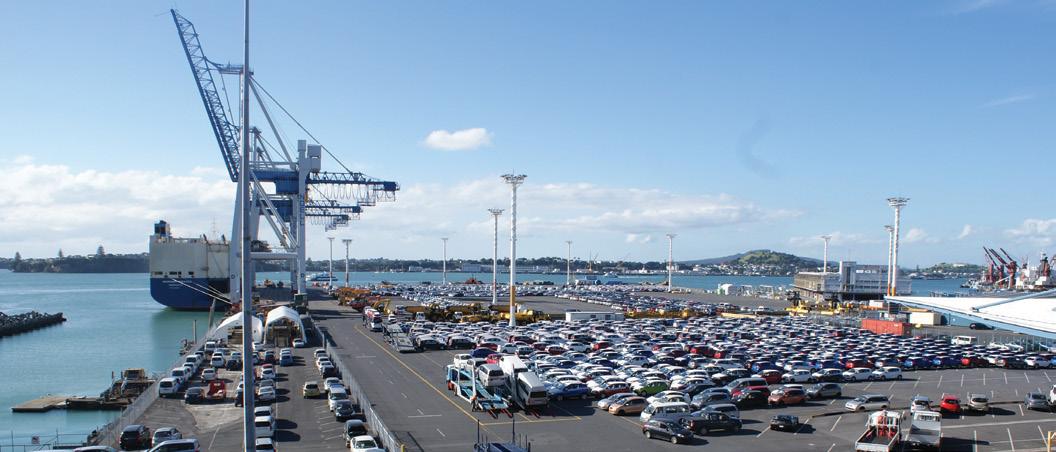
Toyota’s Aqua was the top model with 1,068 sales – a 14.6 per cent jump from 932 units in November 2021.
Toyota’s Prius was second with 600 units followed by the Mazda Axela on 409.
Completing the top five were the Toyota Corolla with 242 and Mazda’s Demio with 238.
It topped Warrantywise’s 2022 reliability index after also being among the cheapest models to fix, with an average repair cost of £424.31, which comes in at about NZ$843.
The relatively low repair cost of the third-generation Jazz and its low chance of developing a fault gave it a score of 93.7 points out of 100.
MX-5 roadster was fourth with 86.5 and Toyota’s Aygo completed the top five with a score of 85.5.
The Peugeot 107 – part of a platform-sharing venture with the Aygo – was the only European model to make it into the top 10.
SHIFT FOR PREMISES

Archibald & Shorter, which is owned by the Giltrap Group, has opened the doors to its new preowned dealership in Auckland.
“Despite this, consumer arrears appear to be levelling out month-on-month as Kiwis begin to manage this new reality.”
HONDA TAKES TITLE
A favourite for New Zealand importers of used vehicles from Japan has been judged to be the UK’s most reliable model.
The Honda Jazz – also known as the Fit – has taken out the
The index is based on information from more than 131,000 extended warranty policies. It covers cars up to 10 years old that are out of their standard manufacturer warranties and discounts any model when there are fewer than 100 examples covered by the company.
Japanese and Korean marques dominated the rankings with second place taken out by the Mazda 2 on 89.9. It was followed by the Toyota Auris on 89.7. Mazda’s
The group’s premises at 257 Great South Road, Greenlane, stocks second-hand Volvos, Land Rovers and Jaguars. The site was previously home to Winger Suzuki Greenlane. The long-time former tenant recently relocated to 265 Great South Road, which is next to Winger Subaru Greenlane.
The move sees the Archibald & Shorter’s pre-owned facility being much closer to its new-car sites at 550 Great South Road. Its preowned sales were previously at 251 Great South Road.
DOUBLE-GOLD WIN
Turners has taken out double honours at the NZ Advertising Effectiveness Awards. Of seven gold medals awarded, it secured two – for best strategic thinking and retail and e-retail.
The judges described the We Love Tina as a “brilliant case study that was effective in its delivery and had a clear strategy showcasing simplicity at its finest”.
“This is another recognition of the hard work that went into developing this campaign,” says Greg Hedgepeth, chief executive officer of Turners Auto Retail.
www.autofile.co.nz 35 contact: Taka
email:
www.heiwa-auctions.com ü SOLID COMPANY ü QUALITY VEHICLES ü CHOICE & VARIETY OF STOCK ü EXPERIENCED AGENTS ü DEALER ONLY SUPPLIER ü GREAT VALUE FOR MONEY 0 5,000 10,000 15,000 20,000 25,000 Jan Feb Mar Apr May Jun Jul Aug Sep Oct Nov Dec 2018 2019 2020 2021 2022 Used Imported Passenger Registrations - 2018-2022
Arimoto
arimoto@heiwa-auto.co.jp
Focus on cartel agreements
The Commerce Commission has warned the shipping and freight-forwarding industries that alleged Commerce Act breaches are on its radar.
It follows the regulator issuing warnings to eight international freight-forwarding companies because – in its view – they likely entered into cartel agreements with Mondiale Freight Services and or Oceanbridge Shipping to not compete for customers.
The warnings conclude an investigation that began in 2018 into allegations of anticompetitive conduct in freight forwarding, which relates to
logistics for moving cargo in and out of the country.
The companies warned are 360 Logistics Group, Aqua Air Freight Services, CH Robinson Worldwide (NZ), Go Logistics, Kerry Logistics (Oceania), Mainstream Global, Stellar International, and Ryders Customs and Forwarding.
Earlier this year, the commission agreed settlements to resolve proceedings with Mondiale and Oceanbridge.
High-court penalties of $4.9 million were imposed on Mondiale and $4.6m on Oceanbridge.
In addition, four individuals associated with them received
penalties between $65,000 and $100,000.
The combined penalties came in at $9.7m.
The commission considers the cartel agreements made it possible customers were charged more for services than they would have if the companies had actively competed for this business.
The freight-forwarding industry is an important sector of New Zealand’s economy, so the regulator “will continue to focus on identifying potential cartel conduct in global supply chains”.
The alleged arrangements in this case related to agreements
USED IMPORTED PASSENGER VEHICLE ARRIVALS
reached before the Covid-19 pandemic struck. All conduct ceased before April 8, 2021.
Visit www.autofile.co.nz for the full story.
IMPORT LEVELS DOWN
There were 6,279 used passenger vehicles imported during November and, of those, 5,975 came in from Japan. Australia placed second with 139 units. Next up were Singapore and the US on 57 each, and the UK with 41.
The year-to-date total now stands at 82,022, which is down by 31.3 per cent from 119,430 at the same time last year.
36 www.autofile.co.nz Door-to-Door
ContaCt us today! To and from Japan, USa, UK, aUSTralia, Singapore, and The pacific Ph +64 9 303 0075 www.mmnz.biz www.mmnz.biz
vehicle shipping experts
6,000 4,000 JAN FEB MAR APR MAY JUN JUL AUG SEPT OCT NOV DEC 2014 2015 2017 2021 2018 2020 2019 2016 2013 2022 Used Imported Passenger Vehicles By Country Of Export COUNTRY OF EXPORT 2022 2021 2020 JAN ’22 FEB ’22 MAR ’22 APR ’22 MAY ’22 JUN ’22 JUL ’22 AUG ’22 SEPT ’22 OCT ’22 NOV ’22 NOV SHARE % 2022 TOTAL 2021 TOTAL MRKT SHARE 2020 TOTAL MRKT SHARE Australia 262 235 226 233 172 234 187 177 204 152 139 2.2% 2,221 3,072 2.4% 4,185 3.9% Great Britain 60 41 59 35 55 70 23 24 22 36 41 0.7% 466 1,259 1.0% 690 0.6% Japan 6,490 6,751 7,477 7,636 11,497 8,254 6,206 8,295 4,829 4,827 5,975 94.9% 78,237 123,508 94.8% 100,994 92.9% Singapore 46 69 33 47 33 38 24 21 32 11 57 0.9% 411 1,378 1.1% 1,846 1.7% USA 44 20 75 33 59 30 41 42 16 28 57 0.9% 445 697 0.5% 480 0.4% Other countries 31 33 20 15 17 23 17 35 15 8 28 0.4% 242 403 0.3% 468 0.4% Total 6,933 7,149 7,890 7,999 11,833 8,649 6,498 8,594 5,118 5,062 6,297 100.0% 82,022 130,317 100.0% 108,663 100.0%
20,000 19,000 18,000 17,000 16,000 15,000 14,000 13,000 12,000 11,000 10,000 9,000 8,000 7,000
Companies team up for venture
MTF Finance and Tower have unveiled a partnership that aims to make the purchase and insurance process easier for the finance company’s customers.
The deal means when consumers take out a loan with MTF, they can insure their new assets through Tower at the same time. For vehicles, this can be done before they drive it off the yard.


Chris Lamers, MTF Finance’s chief executive officer, says the company is delighted to work with Tower to “offer a wider range of insurances in a seamless manner”.
“Both companies are locally
owned and operated, and share a passion for helping New Zealanders,” he adds.
“As MTF accelerates its growth, we’re working with partners to add more ways we can assist our customers and insurance is a key priority for us. We want to ensure that when someone is borrowing money to buy a specific asset, they have the right protection in place for that asset.”
Jonathan Beale, Tower’s managing director of partnerships, notes the move comes as consumers are shifting to more sustainable vehicles.
“We’re certainly starting to
see the effects of the clean car scheme with the number of electric vehicles [EVs] we insure growing by 78 per cent in 2022,” he says.
“Nationally, new EV registrations doubled in the third quarter of this year compared to the average over the previous four. EVs and hybrids now make up 40 per cent of New Zealand’s top-selling models.”
Under the partnership, MTF Finance customers can now access Tower products online or over the phone, and will also have access to the My Tower platform where they can update, claim on and manage their insurance online.
Beale adds: “Combined, Tower
and MTF have more than 200 years’ experience helping Kiwis purchase and protect the things that matter most to them. This partnership is a great fit.”
There are 51 MTF Finance franchises plus hundreds of MTFcertified dealerships nationwide.


TWO-UNIT DIFFERENCE
Traders sold 15,979 second-hand cars sold to the public in November. That was up from 15,977, or by two units, when compared to the same month of last year.
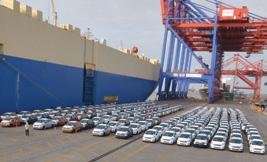
There were 12,904 trade-ins last month, which was a drop of seven per cent from 13,879.
692 756 -8.5 Gisborne 133 151 -11.9 0.83 336 365 -7.9 40 57 -29.8 Hawke’s Bay 588 678 -13.3 3.68 1,330 1,355 -1.8 381 470 -18.9 Taranaki 366 406 -9.9 2.29 998 1,016 -1.8 191 219 -12.8 Manawatu-Whanganui 858 920 -6.7 5.37 1,961 2,093 -6.3 896 915 -2.1 Wellington 1,519 1,701 -10.7 9.51 3,092 3,520 -12.2 1,095 1,110 -1.4 Tasman 145 136 6.6 0.91 423 495 -14.5 22 26 -15.4 Nelson 136 145 -6.2 0.85 454 488 -7.0 159 156 1.9 Marlborough 141 160 -11.9 0.88 348 375 -7.2 86 110 -21.8 West Coast 106 134 -20.9 0.66 284 321 -11.5 43 47 -8.5 Canterbury 2,144 2,162 -0.8 13.42 4,957 5,224 -5.1 1,937 2,067 -6.3 Otago 759 775 -2.1 4.75 1,865 2,006 -7.0 417 551 -24.3 Southland 329 323 1.9 2.06 900 1,033 -12.9 154 264 -41.7 Other 51 65 -21.5 0.32 184 150 22.7 0 293 -100.0 NZ Total 15,979 15,977 0.0 100.00 37,819 40,439 -6.5 12,904 13,879 -7.0
www.autofile.co.nz 37
SECONDHAND CAR SALES - November 2022 DEALER TO PUBLIC PUBLIC TO PUBLIC PUBLIC TO DEALER REGION NOV '22 NOV ’21 +/- % MARKET SHARE NOV '22 NOV ’21 +/- % NOV '22 NOV ’21 +/- % Northland 547 539 1.5 3.42 1,785 1,865 -4.3 183 265 -30.9 Auckland 5,476 5,014 9.2 34.27 12,329 13,211 -6.7 5,514 5,417 1.8 Waikato 1,607 1,564 2.7 10.06 3,830 3,971 -3.6 1,094 1,156 -5.4 Bay of Plenty 1,074 1,104 -2.7 6.72 2,743 2,951 -7.0
Visit autofile.co.nz/jobs to view the latest jobs in the automotive industry
New Passenger Vehicle Sales by Make - November 2022
Toyota 1,654 2,126 -22.2 14.8% 15,814 14.7%
Tesla 1,365 408 234.6 12.2% 5,726 5.3%
Mitsubishi 1,306 1,935 -32.5 11.7% 16,277 15.1%
Suzuki 929 620 49.8 8.3% 7,732 7.2%
Kia 830 1,144 -27.4 7.4% 11,008 10.2%
Hyundai 569 875 -35.0 5.1% 7,155 6.6%
BYD 475 0 47,500.0 4.3% 1,368 1.3%
MG 471 463 1.7 4.2% 4,855 4.5%
Nissan 440 480 -8.3 3.9% 2,183 2.0%
Mazda 392 299 31.1 3.5% 5,045 4.7%
Ford 388 331 17.2 3.5% 2,723 2.5%
Honda 328 424 -22.6 2.9% 3,603 3.3%
Skoda 324 167 94.0 2.9% 2,069 1.9%
Volkswagen 251 277 -9.4 2.2% 2,675 2.5%
Subaru 207 204 1.5 1.9% 2,272 2.1%
Haval 173 259 -33.2 1.5% 2,140 2.0%
BMW 146 106 37.7 1.3% 1,559 1.4%
Audi 137 156 -12.2 1.2% 1,498 1.4%
Mercedes-Benz 124 138 -10.1 1.1% 1,932 1.8%
Peugeot 109 132 -17.4 1.0% 1,464 1.4%
Polestar 108 10 980.0 1.0% 796 0.7%
Volvo 76 53 43.4 0.7% 742 0.7%
Cupra 49 23 113.0 0.4% 319 0.3%
Lexus 45 90 -50.0 0.4% 973 0.9%
Land Rover 39 26 50.0 0.3% 1,298 1.2%
Mini 36 54 -33.3 0.3% 763 0.7%
Porsche 26 12 116.7 0.2% 561 0.5%
Opel 24 0 2,400.0 0.2% 53 0.0% SsangYong 24 78 -69.2 0.2% 621 0.6% Jeep 21 104 -79.8 0.2% 435 0.4%
Renault 16 45 -64.4 0.1% 235 0.2% Citroen 14 18 -22.2 0.1% 278 0.3%
Jaguar 13 4 225.0 0.1% 397 0.4%
Isuzu 11 25 -56.0 0.1% 261 0.2%
Fiat 10 16 -37.5 0.1% 183 0.2%
LDV 9 32 -71.9 0.1% 156 0.1%
Can-Am 8 9 -11.1 0.1% 65 0.1%
Aston Martin 4 13 -69.2 0.0% 58 0.1%
Ferrari 4 2 100.0 0.0% 27 0.0%
Maserati 4 0 400.0 0.0% 59 0.1%
Seat 4 25 -84.0 0.0% 118 0.1%
Alfa Romeo 3 9 -66.7 0.0% 86 0.1%
Yamaha 3 5 -40.0 0.0% 52 0.0% Chevrolet 2 0 200.0 0.0% 28 0.0% Others 5 25 -80.0 0.0% 220 0.2% Total 11,176 11,222 -0.4 100.0% 107,882 100.0%
New Passenger Vehicle Sales by Model - November 2022
MAKE
Tesla Model Y 1,099 0 109,900.0 9.8% 3,358 3.1%
Mitsubishi Outlander 599 1,015 -41.0 5.4% 8,769 8.1%
Toyota RAV4 572 724 -21.0 5.1% 5,597 5.2%
BYD Atto 3 475 0 47,500.0 4.3% 1,368 1.3%
Suzuki Swift 438 262 67.2 3.9% 3,564 3.3%
Mitsubishi ASX 397 604 -34.3 3.6% 3,042 2.8%
MG ZS 360 262 37.4 3.2% 2,981 2.8%
Nissan X-Trail 310 314 -1.3 2.8% 1,501 1.4%
Kia Sportage 298 37 705.4 2.7% 3,035 2.8%
Tesla Model 3 266 408 -34.8 2.4% 2,368 2.2%
Mitsubishi Eclipse Cross 245 241 1.7 2.2% 3,402 3.2%
Ford Everest 237 183 29.5 2.1% 1,139 1.1%
Honda Jazz 223 230 -3.0 2.0% 2,256 2.1%
Toyota Corolla 220 733 -70.0 2.0% 2,488 2.3%
Toyota Yaris Cross 212 108 96.3 1.9% 1,767 1.6%
Suzuki Vitara 192 90 113.3 1.7% 1,163 1.1%
Hyundai Staria 184 0 18,400.0 1.6% 245 0.2%
Mazda CX-5 172 73 135.6 1.5% 2,189 2.0%
Toyota Corolla Cross 167 0 16,700.0 1.5% 371 0.3%
Kia Carnival 163 122 33.6 1.5% 566 0.5%
Suzuki Jimny 155 85 82.4 1.4% 1,362 1.3%
Skoda Kodiaq 133 30 343.3 1.2% 630 0.6%
Hyundai Kona 128 294 -56.5 1.1% 2,359 2.2%
Haval H6 113 98 15.3 1.0% 1,186 1.1%
Toyota Highlander 110 142 -22.5 1.0% 1,595 1.5%
Polestar Polestar 2 108 10 980.0 1.0% 796 0.7%
Hyundai Santa Fe 97 229 -57.6 0.9% 984 0.9%
Kia Stonic 97 304 -68.1 0.9% 2,051 1.9%
Toyota Yaris 94 90 4.4 0.8% 1,331 1.2%
Honda CR-V 93 107 -13.1 0.8% 972 0.9%
Suzuki Ignis 83 76 9.2 0.7% 695 0.6%
Toyota Land Cruiser Prado 83 106 -21.7 0.7% 605 0.6%
Kia Niro 82 56 46.4 0.7% 1,068 1.0%
Skoda Superb 81 60 35.0 0.7% 689 0.6%
Toyota C-HR 77 112 -31.3 0.7% 734 0.7%
Nissan Qashqai 76 116 -34.5 0.7% 136 0.1%
Subaru Forester 72 20 260.0 0.6% 536 0.5%
Subaru Outback 72 111 -35.1 0.6% 953 0.9%
Haval Jolion 60 160 -62.5 0.5% 954 0.9%
Hyundai Ioniq 60 60 0.0 0.5% 1,391 1.3%
MG HS 60 145 -58.6 0.5% 1,046 1.0%
Ford Escape 57 67 -14.9 0.5% 558 0.5%
Audi Q3 56 22 154.5 0.5% 363 0.3%
Ford Puma 56 27 107.4 0.5% 482 0.4%
Suzuki S-Cross 53 0 5,300.0 0.5% 228 0.2%
Others 2,191 3,289 -33.4 19.6% 33,009 30.6%
Total 11,176 11,222 -0.4 100.0% 107,882 100.0%
38 www.autofile.co.nz
2022 YEAR TO DATE 2022
MAKE NOV '22 NOV ’21 +/- % NOV '22 MKT SHARE
MKT SHARE
MKT
2022 YEAR
MODEL NOV '22 NOV ’21 +/- % NOV '22
SHARE
TO DATE 2022 MKT SHARE
new cars
Looking further than fossil fuels
The group managing director of Farmer Autovillage in Mount Maunganui says more customers are now looking at whether they should make the jump to alternative fuel options when it comes to powering their new purchases.
Mike Farmer’s company represents a plethora of marques, such as Volkswagen, Nissan, Skoda, Audi, Jeep, Ram, Subaru, Haval, GWM, ORA, MG, Cupra and Seat, with some having models in the non-fossil fuels sector.
“However, with the onslaught of new-model arrivals across all our brands, we will have the biggest selection of electric vehicles [EVs] in the Bay by far in 2023,” he told Autofile.
“When it comes to securing vehicles, we’ve got to get the balance right between internal combustion engines and alternative fuels from a stockholding perspective as people consider their options.
“We as a total sales team have taken an unrelenting approach to forward orders with a solid bank of these resulting.”
Farmer notes coronavirus still has a “a sting in its tail, which I know is being felt across all industries. This is especially felt when you have a reduction in capacity in your productive –chargeable – team members”.
He adds: “With the challenges faced with Covid-19 absenteeism, especially in after-sales, we have managed to redeploy team members to areas of the company that have high demand, such as the retail labour workshop from our [pre-delivery inspection] centre, while the industry is experiencing inconsistent supply of new vehicles.”
TOP MODEL RELEASES
The Nissan X-Trail has emerged as New Zealand’s most-anticipated car release of the year, according to Auto Trader.
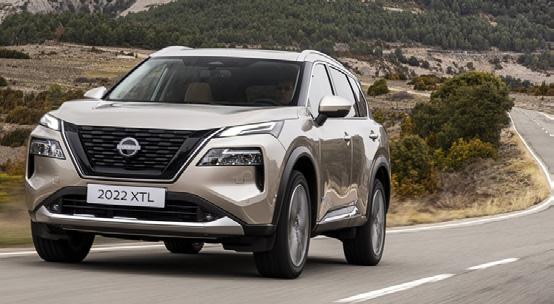
A study by the online marketplace compared the number
of Google searches made in the past 12 months for more than 50 models being released in 2022 and 2023.
The X-Trail took top spot with an average of 5,780 searches a month. It was followed by Honda’s Civic e:HEV with 2,410. The BMW X1 came third on 1,370.
BMWs proved particularly popular for New Zealanders and the luxury marque had four models in the top 10 most searched-for releases. Its X1 was the highest placed in third, while the Z4, M2 and 7 Series were fourth, fifth and 10th respectively.
Also making the top 10 were Maserati’s GranTurismo, the all-electric Polestar 3, Volkswagen’s Amarok, which is due to hit the market early next year, and Toyota’s Corolla Cross.
Some top-end vehicles appeared lower down the search ladder. They included the Lucid
Pure Air in 12th position, Aston Martin’s Valhalla in 13th and the Electric DeLorean DM in 16th.
Erin Baker, Auto Trader’s editorial director, says: “Surprisingly, it’s not just the more premium or aspirational brands making the top 10 with the more family-focused X-Trail coming in first. Clearly, functionality can be just as important as speed.”
Electric model best-seller
There were 11,176 new cars sold in November, which was only 0.4 per cent fewer than the 11,222 registered in the same month of 2021. The top model was Tesla’s Model Y with 1,099 units for a 9.8 per cent share of the market. Mitsubishi’s Outlander was second with 599 and Toyota’s RAV4 was third on 572. The BYD Atto 3 was fourth on 475 and Suzuki’s Swift fifth on 438.
Nissan’s X-Trail also received plenty of attention via Google searches in the UK, US and Australia.
NEW AIRPORT BRANCH
Sixt New Zealand, the premium subscription and car-rental business owned by the Giltrap Group, opened its sixth in-terminal location last month.
Dunedin Airport has joined a line-up of existing branches across Auckland, Wellington, Christchurch and Queenstown.
Dane Fisher, chief executive officer, says: “Looking ahead to the next 12 months, Sixt is entering an exciting growth phase.
“Offering a seamless in-terminal experience for travellers to Dunedin in time for summer gets us one step closer to achieving our vision of 12 in-terminal locations by 2025.”
The new branch will provide traditional short-term rentals, and the company’s “subscribe monthly” and “subscribe new” packages.
Sixt’s line-up includes electric models, SUVs, luxury and premium cars, and sports and service vehicles.
GETTING POWERED UP
A plan for EV owners aims to make it cheaper and easier for drivers to recharge while away from home.
Genesis’ EVerywhere plan allows users to access ChargeNet sites for the same rate they pay at home, with the power provider saying this can save up to 70 per cent on the cost of charging.
The company notes drivers are charged the same rate regardless of if they use a fast, rapid or hyperrapid charger with the cost added to their regular power bills.
Peter Kennedy, chief digital officer at Genesis, says the “energy roaming” scheme for EVs was trialled over a number of months with 100 customers.
“Once people had EVerywhere, they were more comfortable travelling further. In some cases, we saw pilot customers try out public charging for the first time.”
www.autofile.co.nz 39 new cars
Jan Feb Mar Apr May Jun Jul Aug Sep Oct Nov Dec 2018 2019 2020 2021 2022
0 1,000 2,000 3,000 4,000 5,000 6,000 7,000 8,000 9,000 10,000 11,000 12,000
New Passenger Registrations - 2018-2022
Nissan’s new X-Trail
Going green to cut pollution
NZ Post has taken the first shipment of its 60-strong fleet of fully electric eVito vans as it seeks to cut carbon dioxide (CO2) emissions as part of a $20 million initiative.
The company has received 22 units with the remainder expected to arrive by the end of 2022 in what was the largest international single order of electric MercedesBenz vans at the time by a commercial operator.
“This is an exciting step towards a more sustainable future for Mercedes-Benz Vans and our partner NZ Post,” says Diane Tarr, managing director of Mercedes-Benz Vans Australia and New Zealand.
“We’re now ready with a strong
customer-centric electric product portfolio. We can’t wait to see the eVito come to life on the road through NZ Post and its delivery partners.”
The vans are replacements for
diesel and petrol models used by NZ Post and some of its delivery partners, and will help it to achieve its goal to reduce its CO2 emissions by one-third by 2030. NZ Post teamed up with New
Zealand Green Investment Finance (NZGIF) to overcome supply-chain challenges thanks to the bulk purchase of electric vehicles (EVs).
Both companies have contributed $10m to buy the eVitos, fund the roll-out of their charging infrastructure and help contractors with access costs.
Dawn Baggaley, group sustainability manager, says NZ Post aims to have its own fleet, and one-quarter of its last-mile delivery contractor fleet, electric by 2025 –with the balance of its contractors’ vehicles being electric five years after that.
“EVs cost a lot less to run, but initial purchasing costs can be a barrier,” adds Baggaley.
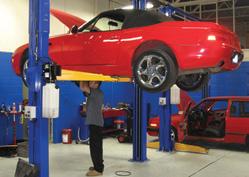
Nissan Navara 147 416 -64.7 3.3% 1,889 4.2%

Toyota Hiace 99 305 -67.5 2.2% 1,522 3.4% Mercedes-Benz Sprinter 92 53 73.6 2.1% 712 1.6%
Isuzu D-Max 77 216 -64.4 1.7% 1,726 3.8% Fiat Ducato 59 121 -51.2 1.3% 596 1.3% Isuzu N Series 58 50 16.0 1.3% 446 1.0%

LDV eT60 51 0 5,100.0 1.1% 62 0.1% Mazda BT-50 47 137 -65.7 1.1% 725 1.6%
Isuzu F Series 46 39 17.9 1.0% 430 1.0%
Ford Transit 45 78 -42.3 1.0% 416 0.9%
Hino 500 44 39 12.8 1.0% 436 1.0%
LDV Deliver 9 41 57 -28.1 0.9% 483 1.1%
Iveco Daily 40 19 110.5 0.9% 257 0.6%
Hyundai Staria Load 39 26 50.0 0.9% 502 1.1%
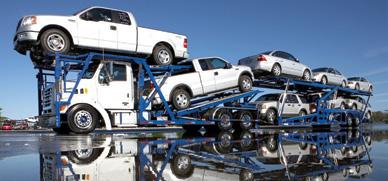
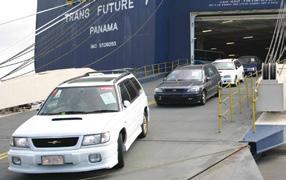
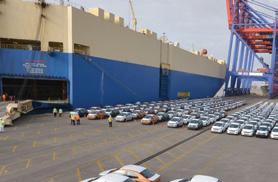
Fuso Canter 616-City 37 34 8.8 0.8% 337 0.7%
LDV T60 37 47 -21.3 0.8% 598 1.3%
Hino 300 34 31 9.7 0.8% 316 0.7%
Others 687 932 -26.3 15.5% 8,191 18.1%
Total 4,445 5,116 -13.1 100.0% 45,145 100.0%
40 www.autofile.co.nz Know what’s going on in YOUR industry
Jan
Jul
Sep
2018
2022 New Commercial Sales - 2018-2022 New Commercial Sales by Make - November 2022 MAKE NOV '22 NOV ’21 +/- % NOV '22 MKT SHARE 2022 YEAR TO DATE 2022 MKT SHARE Ford
Toyota
17
Volvo 25 13
Others 139 232
Total 4,445 5,116 -13.1 100.0% 45,145 100.0% New Commercial Sales by Model - November 2022 MAKE MODEL NOV '22 NOV ’21 +/- % NOV '22 MKT SHARE 2022 YEAR TO DATE 2022 MKT SHARE Ford
0 1,000 2,000 3,000 4,000 5,000 6,000 7,000 8,000 9,000 10,000
Feb Mar Apr May Jun
Aug
Oct Nov Dec
2019 2020 2021
1,572 1,611 -2.4 35.4% 10,884 24.1%
1,055 998 5.7 23.7% 10,983 24.3% Mitsubishi 333 375 -11.2 7.5% 6,342 14.0% Isuzu 194 316 -38.6 4.4% 2,786 6.2% LDV 180 254 -29.1 4.0% 2,092 4.6% Nissan 147 416 -64.7 3.3% 1,890 4.2% Fuso 125 106 17.9 2.8% 1,213 2.7% Mercedes-Benz 100 71 40.8 2.2% 846 1.9% Hino 95 79 20.3 2.1% 894 2.0% Volkswagen 86 95 -9.5 1.9% 825 1.8% Fiat 59 121 -51.2 1.3% 597 1.3% Scania 56 47 19.1 1.3% 483 1.1% Iveco 53 35 51.4 1.2% 381 0.8% Mazda 47 137 -65.7 1.1% 725 1.6% Hyundai 43 36 19.4 1.0% 567 1.3% Chevrolet 39 15 160.0 0.9% 240 0.5% UD Trucks 35 29 20.7 0.8% 274 0.6% Great Wall 31 113 -72.6 0.7% 567 1.3% Ram 31
82.4 0.7% 392 0.9%
92.3 0.6% 176 0.4%
-40.1 3.1% 1,988 4.4%
Ranger 1,527 1,533 -0.4 34.4% 10,464 23.2% Toyota Hilux 925 663 39.5 20.8% 9,178 20.3% Mitsubishi Triton 313 320 -2.2 7.0% 5,859 13.0%
new commercials
“Teaming up with NZGIF and offering a competitive finance deal means our contractors can shift into e-vans sooner rather than later.
“There are more than 2,000 vans in our own fleet and last-mile contractor fleet we will transition to electric to meet our sciencebased target.”
NZ Post has structured a deal to offer its contract delivery partners competitive financing and price benefits via a tiered leasing model.
Alongside this, they can access advice from Carbn Asset Management on the best option for individual needs.
“It’s a milestone to celebrate at a time when climate change is impacting our communities,” enthuses Baggaley. “It’s a matter of urgency to do everything we can to reduce emissions and we’re also seeking to assist our delivery
partners shifting to low-carbon delivery.”

Craig Weise, chief executive officer of NZGIF, says: “Not only does this deal help NZ Post electrify its fleet, it will also help kick-start the second-hand commercial EV market as vans are on-sold.”
NZ Post has one of the largest EV delivery fleets in the country,
including more than 400 Paxters that are used by its posties.
It also launched the first hydrogen fuel-cell electric truck for commercial use in New Zealand in July. The Hyundai XCIENT FCEV will save 170 tonnes of CO2 emissions per year – the equivalent to pollution from about 100 fossilfuelled cars.
RANGER SET FOR TITLE
There were 4,445 new commercials registered last month – down by 13.1 per cent compared to 5,116 in November 2021.
Ford’s Ranger was the top model with 1,527 units. It was followed by Toyota’s Hilux on 925 and Mitsubishi’s Triton on 313.
Last month’s results mean the Ranger leads the Hilux by 1,286 units year to date.
However, on the marques ladder for new commercials, Toyota leads Ford by 99 – 10,983 versus 10,884 –with Mitsubishi third on 6,342.

As for used-imported commercials, there were 535 registered last month compared to 743 in November last year for a drop of 28 per cent. The Toyota Hiace was the top model with 128 units. Next up were Nissan’s NV350 on 65 and Hino’s Dutro with 39.
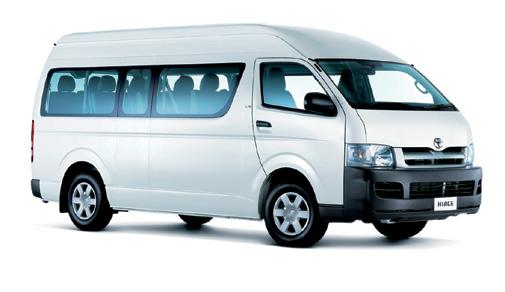
Toyota Hiace 128 189 -32.3 23.9% 1,835 25.7% Nissan NV350 65 84 -22.6 12.1% 1,073 15.1% Hino Dutro 39 58 -32.8 7.3% 425 6.0% Toyota Dyna 32 38 -15.8 6.0% 317 4.4%
Isuzu Elf 30 45 -33.3 5.6% 337 4.7%
Nissan Caravan 21 36 -41.7 3.9% 270 3.8%
Fuso Canter 19 25 -24.0 3.6% 208 2.9%
Nissan NV200 11 0 1,100.0 2.1% 156 2.2%
Toyota Regius 11 6 83.3 2.1% 117 1.6%
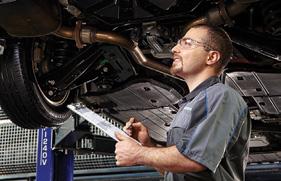
Ford Ranger 10 16 -37.5 1.9% 131 1.8% Hino Ranger 9 17 -47.1 1.7% 156 2.2%
Toyota Toyoace 9 22 -59.1 1.7% 132 1.9%
Isuzu Forward 8 18 -55.6 1.5% 126 1.8%
Nissan Atlas 8 15 -46.7 1.5% 117 1.6%

Suzuki Carry 8 5 60.0 1.5% 68 1.0%
Daihatsu Hijet 7 6 16.7 1.3% 104 1.5%
Chevrolet Colorado 7 8 -12.5 1.3% 86 1.2%
Toyota Hilux 7 5 40.0 1.3% 96 1.3%
Ford F-150 6 8 -25.0 1.1% 51 0.7%
Chevrolet C10 5 4 25.0 0.9% 34 0.5%
Others 95 138 -31.2 17.8% 1,289 18.1%
Total 535 743 -28.0 100.0% 7,128 100.0%
www.autofile.co.nz 41
0 500 1,000 1,500 2,000 2,500 Jan Feb Mar Apr May Jun Jul Aug Sep Oct Nov Dec 2018 2019 2020 2021 2022 Used Commercial Sales - 2018-2022 Used Commercial Sales by Make - November 2022 MAKE NOV '22 NOV ’21 +/- % NOV '22 MKT SHARE 2022 YEAR TO DATE 2022 MKT SHARE Toyota 193 266 -27.4 36.1% 2,577 36.2% Nissan 117 147 -20.4 21.9% 1,781 25.0% Hino 51 76 -32.9 9.5% 618 8.7% Isuzu 41 68 -39.7 7.7% 515 7.2% Mitsubishi 30 42 -28.6 5.6% 345 4.8% Ford 22 37 -40.5 4.1%
Chevrolet 13 10
Holden 9 12
146
Suzuki 8 5
73
Daihatsu 7 6
UD Trucks 5 8
Volkswagen 5 14
LDV 4 0
Mazda 4 10
Total 535
Commercial Sales by Model - November 2022 MAKE MODEL NOV '22 NOV ’21 +/- % NOV '22 MKT SHARE 2022 YEAR TO DATE 2022 MKT SHARE
265 3.7%
30.0 2.4% 99 1.4%
-25.0 1.7%
2.0%
60.0 1.5%
1.0%
16.7 1.3% 105 1.5%
-37.5 0.9% 52 0.7%
-64.3 0.9% 60 0.8%
400.0 0.7% 12 0.2%
-60.0 0.7% 108 1.5% Iveco 3 3 0.0 0.6% 20 0.3% Land Rover 3 1 200.0 0.6% 5 0.1% Mercedes-Benz 3 5 -40.0 0.6% 28 0.4% Volvo 3 0 300.0 0.6% 22 0.3% DAF 2 5 -60.0 0.4% 17 0.2% Kenworth 2 2 0.0 0.4% 27 0.4% Others 10 26 -61.5 1.9% 253 3.5%
743 -28.0 100.0% 7,128 100.0% Used
Subscribe now at www.autofile.co.nz/subscribe INSIGHT Keep up to date with the latest automotive news used commercials t
Sales of popular model spike
Suzuki says New Zealand’s most popular small car is making gains thanks to increased sales, which in turn is bolstering its domination of the light-vehicle sector.
While registrations of all new passenger cars rose by 1.5 per cent by the end of October, the Swift’s jumped by 29 per cent.
At the same time, the model’s penetration of the light-car segment increased to a class-leading 32.1 per cent. That was up from a 30.1 per cent share when compared to the first 10 months of last year.

The Swift has been Suzuki NZ’s bestselling model since 2005. While the current iteration is new from the ground up, it continues to offer attributes that have made the nameplate a Kiwi favourite, says Gary Collins, general manager of motor-vehicle marketing.
Its sales over the first 10 months of this year were 53.5 per cent higher than the second best-selling model in the light segment, adds Collins.
“Consumers like the light controls, responsiveness and fun factor of the Swift. As with other Suzukis, it has a reputation for reliability and they appreciate its five-star Ancap rating across all automatic versions.”
Five of its seven variants available in New Zealand qualify for rebates under the clean car discount. The entry-level 1.2 GL manual has a recommended retail price of $21,990 and qualifies for a $2,593.45 rebate.
The Swift Hybrid has an official combined fuel-consumption rate of 4.1l/100km on the NEDC and “remarkably” low emissions of 94g/km, which entitles it to a feebate incentive of $3,160.52.
Meanwhile, the four-wheel-drive Jimny has also been making sales gains thanks to high demand for this vehicle.
Its year-to-date sales to the end of October were up by 11.8 per cent with the small SUV market contracting by 12 per cent.
The Jimny has increased its market share of the small SUV sector by 27 per cent compared to the same period of 2021.
While total new passenger vehicle and SUV sales had risen by 3.8 per cent by the start of November, Suzuki’s volumes jumped by 36.1 per cent with strong demand for all models.
Named one of this country’s cleanest new-vehicle brands, its line-up has also been lifted by the recent arrival of the made over S-Cross Turbo range and improved supplies of its popular Vitara.
Registrations up
Imports of new cars totalled 11,493 in November – the second highest monthly figure this year – and up 41.6 per cent from the same month a year ago. The figure was down 6.3 per cent from October’s 12,260 units.
Registrations of 11,176 new passenger vehicles were completed last month, which was up four per cent from October this year but down 0.4 per cent from November 2021.
The numbers have resulted in the stock of new cars still to be registered increasing by 317 to 83,225. Daily registrations, as averaged over the previous 12 months, stand at 316 units per day – up from 301 a year earlier.
November’s results mean stock at-hand has increased to 263 days, or 8.7 months, if sales continue at the current rate. In the same month of 2021, stock at-hand stood at 273 days.
42 www.autofile.co.nz
Dealer stock of new cars in New Zealand CAR SALES VARIANCE STOCK DAILY SALES - 12-MONTH AVERAGE DAYS STOCK AT HAND IMPORTED REGISTERED Nov ‘21 8,119 11,222 -3,103 82,194 301 273 Dec ‘21 10,322 7,568 2,754 84,948 307 277 Jan ‘22 6,367 8,939 -2,572 82,376 305 270 Feb ‘22 8,517 7,655 862 83,238 302 276 Mar ‘22 10,322 11,200 -878 82,360 305 270 Apr
8,555 8,521 34 82,394 304 271 May
8,488 10,555 -2,067 80,327 306 263 Jun
9,439 9,538 -99 80,228 304 264 Jul
9,368 8,036 1,332 81,560 298 273 Aug
9,928 10,925 -997 80,563 316 255 Sep
11,422 10,590 832 81,395 312 261 Oct
12,260
Year to date 99,792 91,288 Change on last month -6.3% 4.0% 0.4% Change on Nov 2021 41.6% -0.4% 1.3% MORE IMPORTED LESS SOLD MORE STOCK DAYS STOCK IN NZ - NEW CARS 340 320 300 280 260 240 220 200 180 0 NOV DEC JAN FEB MAR APR MAY JUN JUL AUG SEP OCT NOV November 2021 — November 2022 November 2020 — November 2021 Days of stock Fast. Reliable. What more would you need?
‘22
‘22
‘22
‘22
‘22
‘22
‘22
10,747 1,513 82,908 316 262 Nov ‘22 11,493 11,176 317 83,225 316 263
Ships’ crews find dead stink bugs
More than 270 dead brown marmorated stink bugs (BMSBs) have been discovered on roll-on, roll-off vessels heading to New Zealand since the start of the current risk season for the pests.
A Biosecurity NZ spokesperson says ship crews handed the 272 dead creatures found between September 1 and November 2 to officers on arrival. A further 11 dead stink bugs were located in a vehicle from the US.
There were also 10 live interceptions during the same period but none were associated with imported vehicles. The total compares with nine live finds over the same timescale last season.
“The detection of dead bugs shows our offshore treatment requirements and other management measures are
working well,” the spokesperson told Autofile, adding warm weather in Japan has resulted in greater BMSB activity in the lead-up to the high-risk season. This means the likelihood of detections in goods imported from there may increase.
“However, at this stage, we do not assess the risk as greater than other countries with large populations. New Zealand biosecurity personnel recently travelled to Japan to audit local cleaning and inspection operations for used vehicles. They found no significant issues.”
The agency is also keeping a close watch on imports from China after the Australian Department of Agriculture, Fisheries and Forestry (DAFF) recently tightened its rules around BMSBs.
Following a rise in stink-bug detections on Chinese-origin
break-bulk cargo and ro-ro vessels, DAFF announced all ro-ros loaded in Chinese ports must undergo mandatory seasonal pest intervention. The measures also include mandatory fogging and residual spray insecticide following the arrival of those vessels at Australian ports. The steps are in place until January 9, 2023, when they will be reviewed.
Australia’s extra action for its BMSB risk season has reportedly delayed some vessels and has had knock-on effects for their subsequent voyages. The problem is expected to continue while the measures remain in force.
Biosecurity NZ has decided against introducing similar actions for vehicle carriers from China.
“However, we are closely monitoring the situation and will adjust our requirements if needed.”
Daily sales dip
There were 6,297 used cars imported in November, a jump of 24.4 per cent from October when only 5,062 units crossed our borders. However, November’s figure was down 34.7 per cent from the same month a year ago.
A total of 7,156 units were registered last month. This was 1.1 per cent lower than the 7,236 units during October this year and a decrease of 36.8 per cent from the 11,321 registrations in November 2021.
With 859 fewer used cars imported than registered last month, it brought unregistered stock on dealers’ yards, or in compliance shops, to 11,175 units. This was 65.5 per cent below the total of 32,362 at the end of November last year.
Average daily registrations slipped to 312 – down from 335 a year ago – and there was 36 days’ stock remaining.
Dealer stock of used cars in New Zealand
www.autofile.co.nz 43
CAR SALES VARIANCE STOCK DAILY SALES - 12-MONTH AVERAGE DAYS STOCK AT HAND IMPORTED REGISTERED
Year to date 75,089 93,776 Change on last month 24.4% -1.1% -7.1% Change on Nov 2021 -34.7% -36.8% -65.5% LESS IMPORTED LESS SOLD LESS STOCK DAYS STOCK IN NZ - USED CARS 180 160 140 120 100 80 60 40 20 NOV DEC JAN FEB MAR APR MAY JUN JUL AUG SEP OCT NOV Days of stock November 2021 — November 2022 November 2020 — November 2021 www.moana-blue.com 0800 MOANA BLUE (0800 662 622) We pride ourselves on speed of delivery Our aim is to ensure we ship your vehicles as fast as we can cutting out unnecessary and costly delays. With spaces available on next vessel direct sailings from Japan to New Zealand our speed of delivery won’t slow your business down.
Nov ‘21 9,650 11,321 -1,671 32,362 335 97 Dec ‘21 10,766 10,096 670 33,032 337 98 Jan ‘22 6,933 10,103 -3,170 29,862 336 89 Feb ‘22 7,149 10,722 -3,573 26,289 340 77 Mar ‘22 7,890 24,343 -16,453 9,836 377 26 Apr ‘22 7,999 6,500 1,499 11,335 367 31 May ‘22 11,833 6,877 4,956 16,291 355 46 Jun ‘22 8,649 7,405 1,244 17,535 344 51 Jul ‘22 6,498 8,235 -1,737 15,798 331 48 Aug ‘22 8,594 7,935 659 16,457 333 49 Sep ‘22 5,118 7,367 -2,249 14,208 333 43 Oct ‘22 5,062 7,236 -2,174 12,034 324 37 Nov ‘22 6,297 7,156 -859 11,175 312 36
Santa’s new ride produces less emissions !
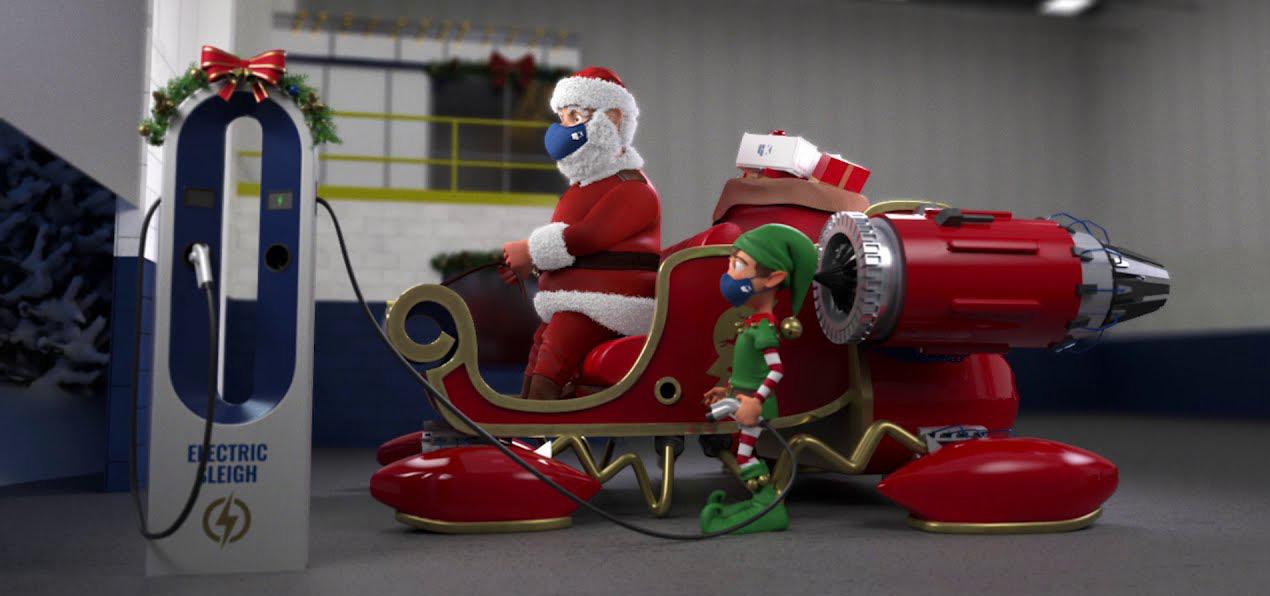
Merry Christmas from all of the
Autohub! www.autohub.co +64 9 411 7425 info@autohub.co.nz GLOBAL VEHICLE LOGISTICS NZ - JAPAN - AUSTRALIA - UK - SINGAPORE
team at









































































































































